Paul van Yperen's Blog, page 211
December 28, 2019
German Film Actors of the 21th Century
A few weeks ago, we bought a series of photos with signatures of German actors. Postcards of modern stars are scarce, but in Germany the 'autogrammkarte' remains a popular fad. This gives us the chance to do a a post on German film actors, who are working now in Germany and abroad. Some are known internationally, like Sebastian Koch, Moritz Bleibtreu and David Kross. Other, like the young Aaron Altaras, will become known soon, we predict. Don't mail us if you miss someone (Where's Christoph Waltz? Why not Daniël Brühl?). It's not a complete or definitive overview of the German film actors of the 21th Century. It's a glimpse, and in alphabetical order. And yes, we will do a female version in 2020.
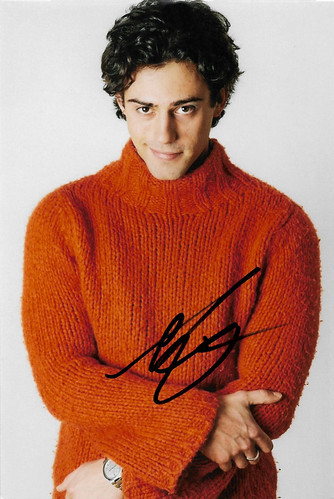
German autograph card, 2018.

German autograph card, 2019.
Aaron Altaras (1995) is one of the most promising German actors of his generation. Altaras had his breakthrough as a teenager in the TV film Nicht alle waren Mörder/Not all were murderers (Jo Baier, 2006), with Nadja Uhl and Hannelore Elsner . As a young adult, he appeared in two interesting films. The first was Die Unsichtbaren/The Invisibles (2017) about four young Jews who learned to hide in plain sight in Berlin during the war. The other is the Swiss romantic drama Mario (2018), about two young football players who get caught up between the politics of the game and the politics of love. His next project is the Mini-series Unorthodox (2020).
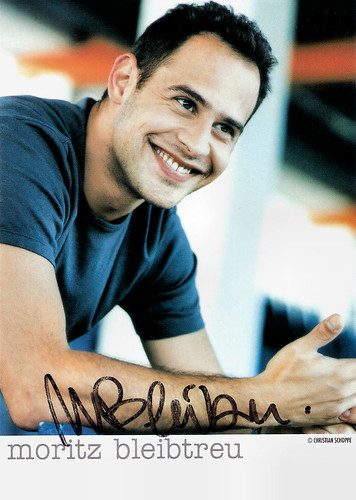
German autograph card. Photo: Christian Schoppe.
Moritz Bleibtreu (1971) is a German actor, whose notable roles include Manni in Lola rennt/Run Lola Run (1998), Tarek Fahd in the psychological thriller Das Experiment/The Experiment (2001) and Andreas Baader in Der Baader Meinhof Komplex/The Baader Meinhof Complex (2008). More recently, he starred in the comedy Es war einmal in Deutschland.../Bye Bye Germany (2017) and the drama Roads (2019).
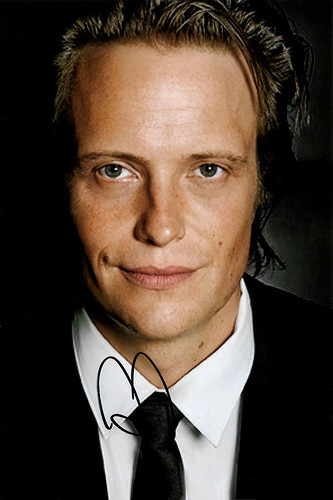
German autograph card.
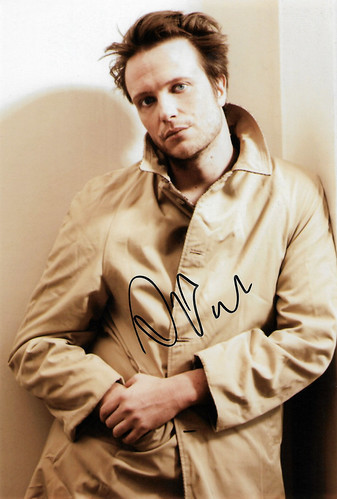
German autograph card.
German actor August Diehl (1976) is primarily known to international audiences as Gestapo major Dieter Hellstrom in Quentin Tarantino's Inglourious Basterds (2009) and as Michael "Mike" Krause, Angelina Jolie's boyfriend, in Salt (2010). He also played leading roles in Die Fälscher/The Counterfeiters (2007), Le jeune Karl Marx/The Young Karl Marx (2017), and Terrence Malick's A Hidden Life (2019).

German autograph card.
German actor Vinzenz Kiefer (1979) is best known for his role as police detective Alexander Brandt in the Krimi series Alarm für Cobra 11 - Die Autobahnpolizei/Cobra 11 (2009-2015), as well as that of Christian Dassault in the action thriller Jason Bourne (2016) with Matt Damon. Next, he can be seen in the Czech historical action drama Medieval (2019) with Ben Foster and Michael Caine.
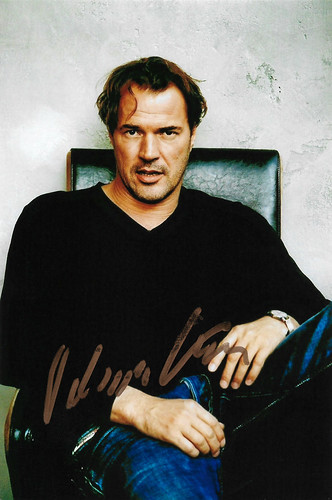
German autograph card.

German autograph card. Photo: Mathias Bothor.
Sebastian Koch (1962) is one of Germany s most multi-faceted and successful television and film actors. He is known for roles in the Academy Award-winning film Leben der Anderen/The Lives of Others (2007), Paul Verhoeven’s Zwartboek/Black Book (2006), Steven Spielberg’s Bridge of Spies (2015), and as Otto Düring in the fifth season of the TV series Homeland (2015-2016). Recently he could be seen in Werk ohne Autor/Never Look Away (2018) with Tom Schilling, and in the Television adaptation of Umberto Eco's novel The Name of the Rose (2019) with John Turturro and Rupert Everett . Announced is the Canadian series Shadowplay (2020), in which he will star with Nina Hoss .

German autograph card.

German autograph card.

German autograph card.
German actor David Kross (1990) played Michael Berg in the critically acclaimed film The Reader (2008) with Kate Winslet . Kross has since worked in both German and English speaking films, including Steven Spielberg's War Horse (2011), Into the White (Petter Næss, 2012) and Race (Stephen Hopkins, 2016). A recent success was the German thriller Ballon/Balloon (2018) with Friedrich Mücke. In post-production is the comedy Betonrausch/Concrete Gold (2020), with Frederick Lau.
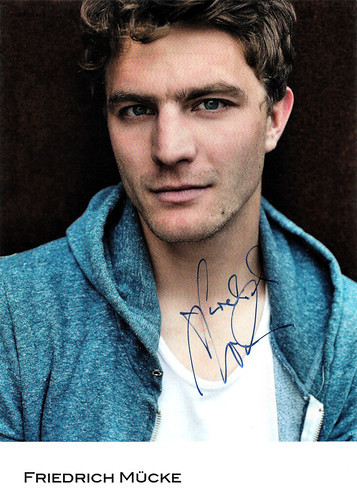
German autograph card. Photo: Alan Ovaska.
Blue-eyed, blond German actor Friedrich Mücke (1981) appeared in more than twenty films since 2006. Many of his films tackle issues around the former GDR. He had his breakthrough with the adventure comedy Friendship! (2010) with Matthias Schweighöfer. He reunited with Schweighöfer in the comedies What a Man (2010), Russendisko/Russian Disco (2012), and Vaterfreuden/Joy of Fatherhood (2014). He co-starred with David Kross in the thriller Ballon/Balloon (2018).
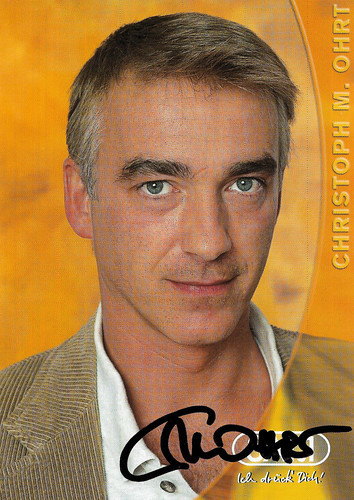
German autograph card by SAT. 1, Berlin. Photo: SAT.1 / Trenkel. Christoph M. Ohrt in the TV series HeliCops (1998-2001).
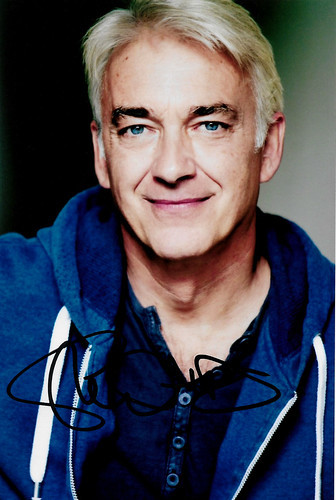
German autograph card.
German actor Christoph M. Ohrt (1960) is best known for his roles in popular TV series like HeliCops - Einsatz über Berlin (1998), and Edel & Starck (2002). He also appeared in German and some international films.
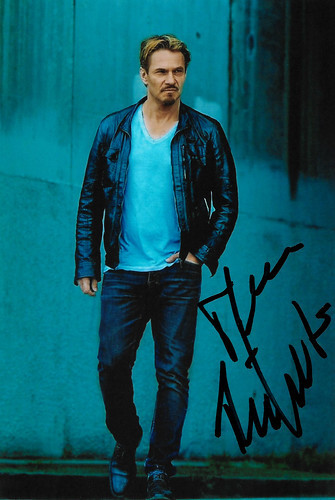
German autograph card.
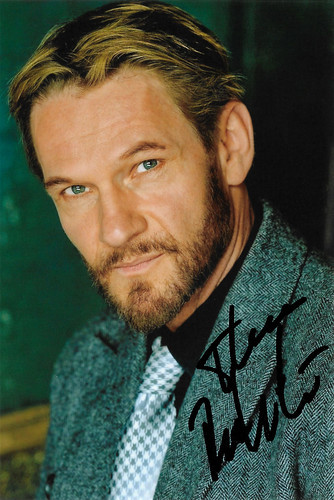
German autograph card.
Thure Riefenstein (1965) is a German-Serbian born actor, writer and producer who started his career at German Broadway theatres such as the Berliner Ensemble and the Hamburger Schauspielhaus. He is best known for playing strong and enigmatic heroes or villains in international films and TV Series. He worked with Steven Soderbergh in Behind the Candelabra (2013), starring Michael Douglas and Matt Damon. On television, he guest-starred in the US-Series Leverage (2012) with Timothy Hutton, The Brink (2015) with Tim Robbins, and the Sci-Fi series 12 Monkeys (2018). Next, he can be seen in the British drama Sophie's War (Joshua Sinclair, 2019) with Anja Kruse, Mikael Persbrandt and Claire Bloom .
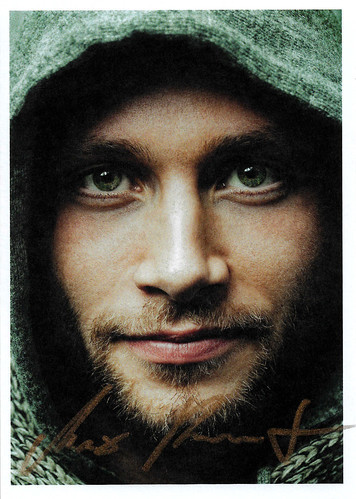
German autograph card. Photo: Glampool / Uwe Martin.
German actor Max Riemelt (1984) is known for such films as Napola - Elite für den Führer (2004), Die Welle/The Wave (2008) and Freier Fall/Free Fall (2013). He had his international breakthrough as Wolfgang Bogdanow in the Netflix series Sense8 (2015-2018), created by The Wachowskis and J. Michael Straczynski. Riemelt is announced in several new films, including the sequel Freier Fall 2/Free Fall 2 (2020).
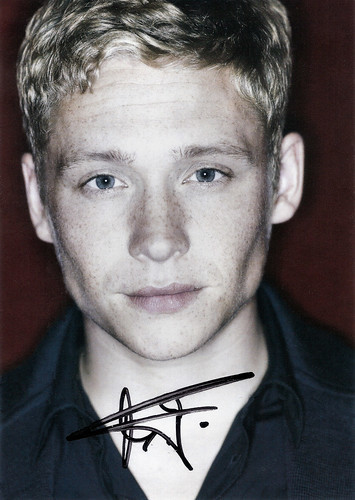
German autograph card. Photo: Lee Strickland.
Blond, freckled and talented Matthias Schweighöfer (1981) is one of the most successful German actors of his generation. He is also a voice actor, singer, film director, and producer. Schweighöfer made his debut as film director with the romantic comedy What a Man (2010). It was well received by German critics and also a success at the box office. He co-starred with Friedrick Mücke in the buddy film Friendship! (2011). He directed, produced and played the lead role in You Are Wanted (2017), Amazon's first non-English-language TV series. Next, he will play Klaus Barbie in Resistance (2020), starring Jesse Eisenberg.
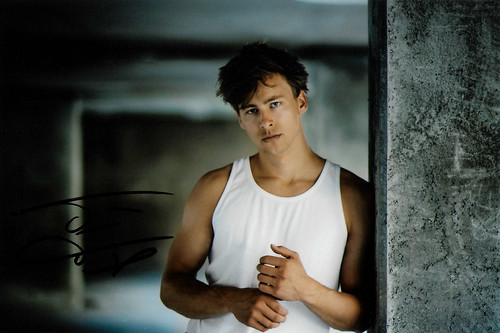
German autograph card.

German autograph card.
Timmi Trinks (1994) is a German actor, best known for the TV series and feature film Allein gegen die Zeit/Alone Against The Time. His latest film was the horror thriller Heilstätten/The Sanctuary (2018).
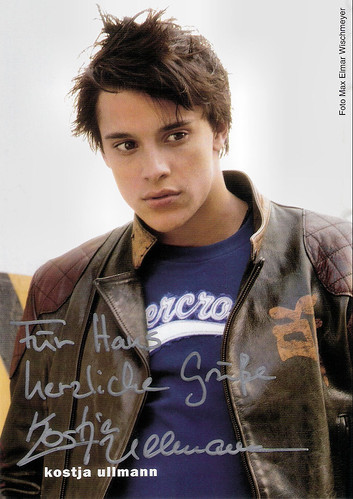
German autograph card. Photo: Max Elmar Wischmeyer.
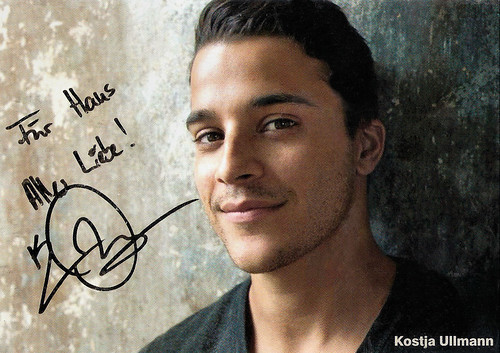
German autograph card. Photo: Vanessa Maas.
Kostja Ullmann (1984) is a German actor, best known for his leading role in the award-winning coming of age drama Sommersturm/Summer Storm (2004) which gained a lot of praise throughout Europe. His later films include Quellen des Lebens/Sources of Life (2013) with Moritz Bleibtreu and Meret Becker, the espionage thriller A Most Wanted Man (2014) starring Philip Seymour Hoffman, and the comedy Mein Blind Date mit dem Leben/My Blind Date With Life (2017). He is announced for the Norwegian action comedy Børning 3 (2020), and the British drama Resonance (2020), with Pat Vega.
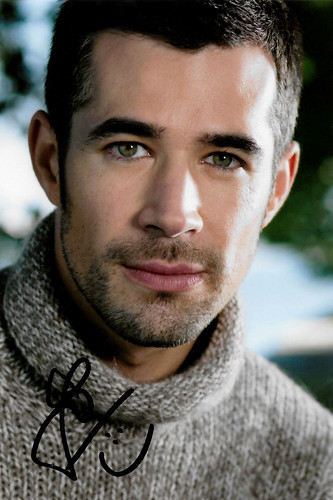
German autograph card.
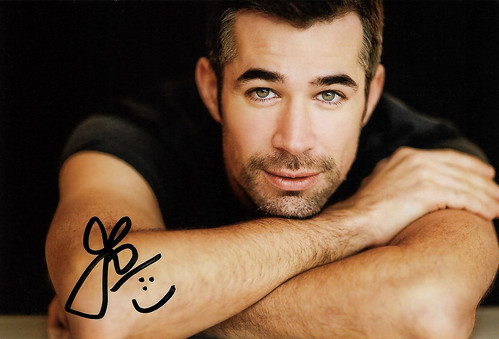
German autograph card.

German autograph card. Photo: Nadine Dilly.
Jo Weil (1977) is a German actor and TV presenter. He is best known for his role of Oliver Sabel in the soap-opera Verbotene Liebe/Forbidden Love. He had played the character for 15 years before trying out other pursuits, including releasing 2 singles, acting in a musical and in several films.
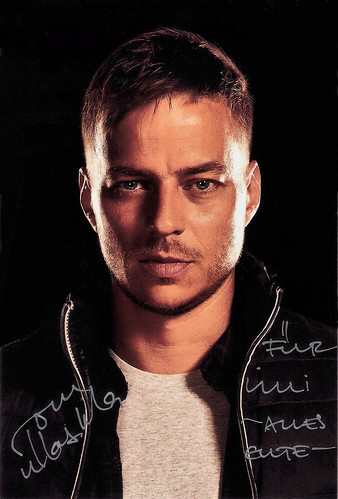
German autograph card.
German actor Tom Wlaschiha (1973) is best known for his role as Jaqen H'ghar in the second, fifth, and sixth seasons of Game of Thrones (2011). He also appeared in films like Resistance (2011) and the TV series Crossing Lines (2013). He recently starred in a new version of the classic series Das Boot (2018). Announced is the Italian comedy L'incredibile storia dell'isola delle rose/The Incredible Story of Rose Island (2020).

German autograph card, 2018.

German autograph card, 2019.
Aaron Altaras (1995) is one of the most promising German actors of his generation. Altaras had his breakthrough as a teenager in the TV film Nicht alle waren Mörder/Not all were murderers (Jo Baier, 2006), with Nadja Uhl and Hannelore Elsner . As a young adult, he appeared in two interesting films. The first was Die Unsichtbaren/The Invisibles (2017) about four young Jews who learned to hide in plain sight in Berlin during the war. The other is the Swiss romantic drama Mario (2018), about two young football players who get caught up between the politics of the game and the politics of love. His next project is the Mini-series Unorthodox (2020).

German autograph card. Photo: Christian Schoppe.
Moritz Bleibtreu (1971) is a German actor, whose notable roles include Manni in Lola rennt/Run Lola Run (1998), Tarek Fahd in the psychological thriller Das Experiment/The Experiment (2001) and Andreas Baader in Der Baader Meinhof Komplex/The Baader Meinhof Complex (2008). More recently, he starred in the comedy Es war einmal in Deutschland.../Bye Bye Germany (2017) and the drama Roads (2019).

German autograph card.

German autograph card.
German actor August Diehl (1976) is primarily known to international audiences as Gestapo major Dieter Hellstrom in Quentin Tarantino's Inglourious Basterds (2009) and as Michael "Mike" Krause, Angelina Jolie's boyfriend, in Salt (2010). He also played leading roles in Die Fälscher/The Counterfeiters (2007), Le jeune Karl Marx/The Young Karl Marx (2017), and Terrence Malick's A Hidden Life (2019).

German autograph card.
German actor Vinzenz Kiefer (1979) is best known for his role as police detective Alexander Brandt in the Krimi series Alarm für Cobra 11 - Die Autobahnpolizei/Cobra 11 (2009-2015), as well as that of Christian Dassault in the action thriller Jason Bourne (2016) with Matt Damon. Next, he can be seen in the Czech historical action drama Medieval (2019) with Ben Foster and Michael Caine.

German autograph card.

German autograph card. Photo: Mathias Bothor.
Sebastian Koch (1962) is one of Germany s most multi-faceted and successful television and film actors. He is known for roles in the Academy Award-winning film Leben der Anderen/The Lives of Others (2007), Paul Verhoeven’s Zwartboek/Black Book (2006), Steven Spielberg’s Bridge of Spies (2015), and as Otto Düring in the fifth season of the TV series Homeland (2015-2016). Recently he could be seen in Werk ohne Autor/Never Look Away (2018) with Tom Schilling, and in the Television adaptation of Umberto Eco's novel The Name of the Rose (2019) with John Turturro and Rupert Everett . Announced is the Canadian series Shadowplay (2020), in which he will star with Nina Hoss .

German autograph card.

German autograph card.

German autograph card.
German actor David Kross (1990) played Michael Berg in the critically acclaimed film The Reader (2008) with Kate Winslet . Kross has since worked in both German and English speaking films, including Steven Spielberg's War Horse (2011), Into the White (Petter Næss, 2012) and Race (Stephen Hopkins, 2016). A recent success was the German thriller Ballon/Balloon (2018) with Friedrich Mücke. In post-production is the comedy Betonrausch/Concrete Gold (2020), with Frederick Lau.

German autograph card. Photo: Alan Ovaska.
Blue-eyed, blond German actor Friedrich Mücke (1981) appeared in more than twenty films since 2006. Many of his films tackle issues around the former GDR. He had his breakthrough with the adventure comedy Friendship! (2010) with Matthias Schweighöfer. He reunited with Schweighöfer in the comedies What a Man (2010), Russendisko/Russian Disco (2012), and Vaterfreuden/Joy of Fatherhood (2014). He co-starred with David Kross in the thriller Ballon/Balloon (2018).

German autograph card by SAT. 1, Berlin. Photo: SAT.1 / Trenkel. Christoph M. Ohrt in the TV series HeliCops (1998-2001).

German autograph card.
German actor Christoph M. Ohrt (1960) is best known for his roles in popular TV series like HeliCops - Einsatz über Berlin (1998), and Edel & Starck (2002). He also appeared in German and some international films.

German autograph card.

German autograph card.
Thure Riefenstein (1965) is a German-Serbian born actor, writer and producer who started his career at German Broadway theatres such as the Berliner Ensemble and the Hamburger Schauspielhaus. He is best known for playing strong and enigmatic heroes or villains in international films and TV Series. He worked with Steven Soderbergh in Behind the Candelabra (2013), starring Michael Douglas and Matt Damon. On television, he guest-starred in the US-Series Leverage (2012) with Timothy Hutton, The Brink (2015) with Tim Robbins, and the Sci-Fi series 12 Monkeys (2018). Next, he can be seen in the British drama Sophie's War (Joshua Sinclair, 2019) with Anja Kruse, Mikael Persbrandt and Claire Bloom .

German autograph card. Photo: Glampool / Uwe Martin.
German actor Max Riemelt (1984) is known for such films as Napola - Elite für den Führer (2004), Die Welle/The Wave (2008) and Freier Fall/Free Fall (2013). He had his international breakthrough as Wolfgang Bogdanow in the Netflix series Sense8 (2015-2018), created by The Wachowskis and J. Michael Straczynski. Riemelt is announced in several new films, including the sequel Freier Fall 2/Free Fall 2 (2020).

German autograph card. Photo: Lee Strickland.
Blond, freckled and talented Matthias Schweighöfer (1981) is one of the most successful German actors of his generation. He is also a voice actor, singer, film director, and producer. Schweighöfer made his debut as film director with the romantic comedy What a Man (2010). It was well received by German critics and also a success at the box office. He co-starred with Friedrick Mücke in the buddy film Friendship! (2011). He directed, produced and played the lead role in You Are Wanted (2017), Amazon's first non-English-language TV series. Next, he will play Klaus Barbie in Resistance (2020), starring Jesse Eisenberg.

German autograph card.

German autograph card.
Timmi Trinks (1994) is a German actor, best known for the TV series and feature film Allein gegen die Zeit/Alone Against The Time. His latest film was the horror thriller Heilstätten/The Sanctuary (2018).

German autograph card. Photo: Max Elmar Wischmeyer.

German autograph card. Photo: Vanessa Maas.
Kostja Ullmann (1984) is a German actor, best known for his leading role in the award-winning coming of age drama Sommersturm/Summer Storm (2004) which gained a lot of praise throughout Europe. His later films include Quellen des Lebens/Sources of Life (2013) with Moritz Bleibtreu and Meret Becker, the espionage thriller A Most Wanted Man (2014) starring Philip Seymour Hoffman, and the comedy Mein Blind Date mit dem Leben/My Blind Date With Life (2017). He is announced for the Norwegian action comedy Børning 3 (2020), and the British drama Resonance (2020), with Pat Vega.

German autograph card.

German autograph card.

German autograph card. Photo: Nadine Dilly.
Jo Weil (1977) is a German actor and TV presenter. He is best known for his role of Oliver Sabel in the soap-opera Verbotene Liebe/Forbidden Love. He had played the character for 15 years before trying out other pursuits, including releasing 2 singles, acting in a musical and in several films.

German autograph card.
German actor Tom Wlaschiha (1973) is best known for his role as Jaqen H'ghar in the second, fifth, and sixth seasons of Game of Thrones (2011). He also appeared in films like Resistance (2011) and the TV series Crossing Lines (2013). He recently starred in a new version of the classic series Das Boot (2018). Announced is the Italian comedy L'incredibile storia dell'isola delle rose/The Incredible Story of Rose Island (2020).
Published on December 28, 2019 22:00
December 27, 2019
The Jungle Book (1967)
The Jungle Book (Wolfgang Reitherman, 1967) was the 19th animated feature by the Disney studio, and the last to be personally supervised by Walt Disney himself.
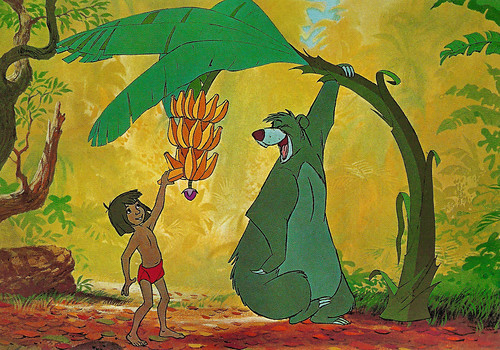
Italian postcard by Grafiche Biondetti, Verona, no. 109/3. Image: Walt Disney Productions. Publicity still for The Jungle Book (Wolfgang Reitherman, 1967).
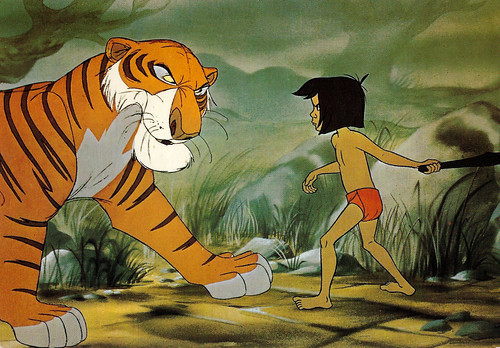
French postcard by Editions G. Picard, Paris, no. WD 8/42. Image: Walt Disney Productions. Publicity still for The Jungle Book (Wolfgang Reitherman, 1967).
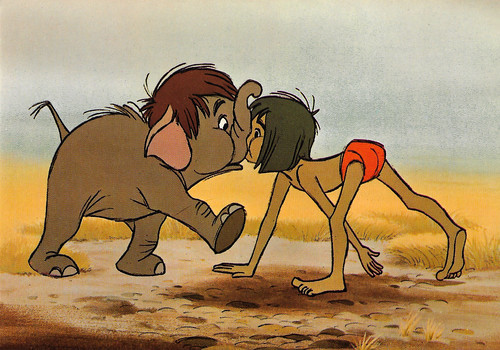
French postcard by Editions Kroma, Casissargues, no. 6. Image: Walt Disney Productions. Publicity still for The Jungle Book (Wolfgang Reitherman, 1967).
Living in the jungle is the best life there is
It was Walt Disney's lead story man and writer Bill Peet who first suggested making an animated version of Rudyard Kipling's 'Jungle Book'.
In the film version, The Jungle Book (Wolfgang Reitherman, 1967), baby Mowgli is abandoned in an Indian jungle after an accident. The black panther Bagheera and brings the 'man cub' to a pack of wolves, who taise the baby.
As the boy grows older, the wise Bagheera realises he must be returned to his own kind in the nearby man-village. Baloo the bear however thinks differently, taking the young Mowgli under his wing and teaching him that living in the jungle is the best life there is.
Bagheera realises that Mowgli is in danger, particularly from Shere Khan the tiger who hates all people. When Baloo finally comes around, Mowgli runs off into the jungle where he survives a second encounter with Kaa the snake and finally, with Shere Khan.
It's the sight of a pretty girl however that gets Mowgli to go to the nearby man-village and stay there. Baloo and Bagheera decide to head home, content that Mowgli is safe and happy with his own kind.
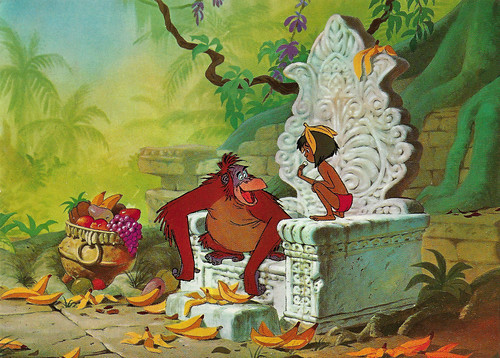
Italian postcard by Grafiche Biondetti, Verona, no. 109/1. Image: Walt Disney Productions. Publicity still for The Jungle Book (Wolfgang Reitherman, 1967).
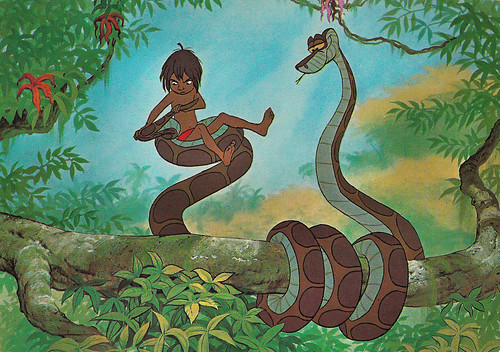
Italian postcard by Grafiche Biondetti, Verona, no. 109/3. Image: Walt Disney Productions. Publicity still for The Jungle Book (Wolfgang Reitherman, 1967).
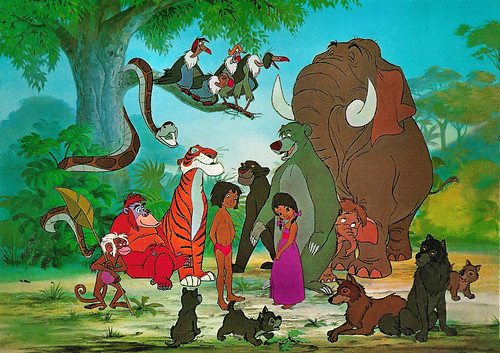
Italian postcard by Grafiche Biondetti, Verona, no. 109. Image: Walt Disney Productions. Publicity still for The Jungle Book (Wolfgang Reitherman, 1967).
The first thing I want you to do is not read it
The Jungle Book (Wolfgang Reitherman, 1967) was the 19th animated feature by the Disney studio, and the last to be personally supervised by Walt Disney himself.
Disappointed by the muted reception to The Sword in the Stone (1963), Walt Disney was determined to come back with a universally well-regarded film. He told his animation crew to "throw away" Rudyard Kipling's book 'The Jungle Book' because the original concept storyboards were too dark and dramatic.
During pre-production, Disney assigned animator Larry Clemmons to head story development on the project. He gave Clemmons a copy of 'The Jungle Book' and told him, "The first thing I want you to do is not read it."
Terry Gilkyson had written a full score initially, but Walt Disney found it also too dark. At the last minute, he threw it away and asked the Sherman brothers to replace it with a more 'fun' score. However, 'Bare Necessities' stayed on at the insistence of others involved in the film, and went on to be nominated for the Academy Award.
The xerographic system, which had been used since 101 Dalmatians (1961), was further refined to combine both Xeroxed cels with hand-inked details. For example, while the basic animation on the village girl at the end of the film was with Xeroxed cels, her mouth was inked by hand. The backgrounds also moved back towards the more traditional look of earlier films.
Ken Anderson storyboarded this scene, the final scene almost at the same time that Richard and Robert Sherman had finished 'My Own Home'. Everything that the Sherman brothers had envisioned while writing the song was up on the storyboards. They brought Anderson up to their office and played him the song and he immediately began to cry.
The film initially became Disney's second highest-grossing animated film in the United States and Canada, and was also successful during its re-releases. The film was successful throughout the world, becoming Germany's highest-grossing film by number of admissions. The film was the seventh most popular sound film of the twentieth century in the UK with admissions of 19.8 million. The film is France's ninth biggest film of all time in terms of admissions with 14.8 million tickets sold.
Disney later released a live-action adaptation, The Jungle Book (Stephen Sommers, 1994), and an animated sequel, The Jungle Book 2 (Steve Trenbirth, 2003). In 2016, a live-action remake was released, The Jungle Book (Jon Favreau, 2016), with voice and motion capture performances from Bill Murray, Ben Kingsley and Idris Elba.
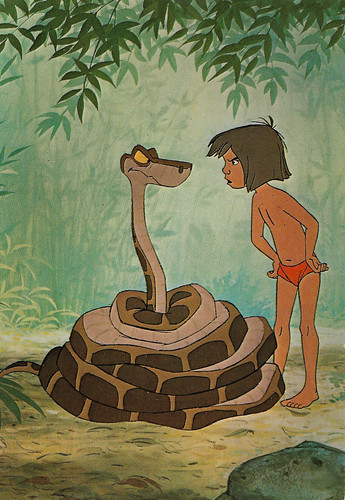
Belgian postcard by Edicorna. Image: Walt Disney Productions. Publicity still for The Jungle Book (Wolfgang Reitherman, 1967).
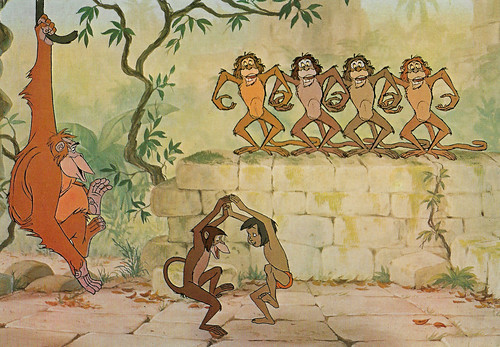
Belgian postcard by Edicorna, no. 3321. Image: Walt Disney Productions. Publicity still for The Jungle Book (Wolfgang Reitherman, 1967).
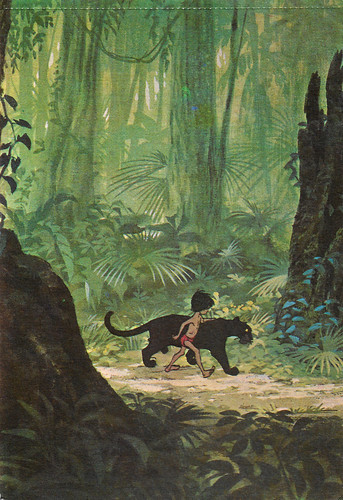
French postcard. Image: Walt Disney Productions. Publicity still for The Jungle Book (Wolfgang Reitherman, 1967).
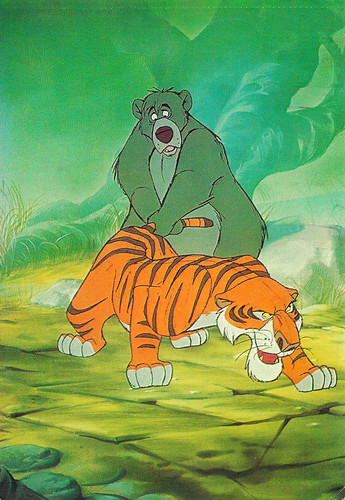
French postcard. Image: Walt Disney Productions. Publicity still for The Jungle Book (Wolfgang Reitherman, 1967).
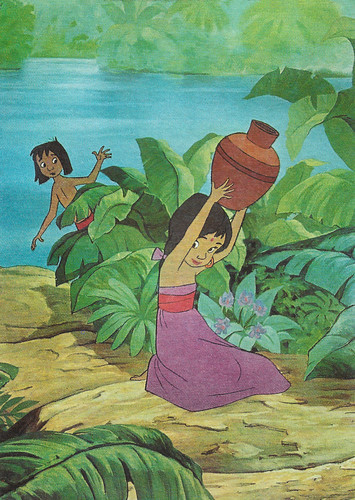
French postcard. Image: Walt Disney Productions. Publicity still for The Jungle Book (Wolfgang Reitherman, 1967).
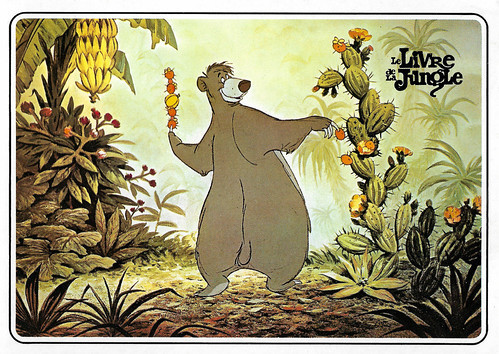
French postcard by MD, no. D 570 4/3. Image: Walt Disney Productions. Publicity still for The Jungle Book (Wolfgang Reitherman, 1967).
Source: Wikipedia and IMDb.

Italian postcard by Grafiche Biondetti, Verona, no. 109/3. Image: Walt Disney Productions. Publicity still for The Jungle Book (Wolfgang Reitherman, 1967).

French postcard by Editions G. Picard, Paris, no. WD 8/42. Image: Walt Disney Productions. Publicity still for The Jungle Book (Wolfgang Reitherman, 1967).

French postcard by Editions Kroma, Casissargues, no. 6. Image: Walt Disney Productions. Publicity still for The Jungle Book (Wolfgang Reitherman, 1967).
Living in the jungle is the best life there is
It was Walt Disney's lead story man and writer Bill Peet who first suggested making an animated version of Rudyard Kipling's 'Jungle Book'.
In the film version, The Jungle Book (Wolfgang Reitherman, 1967), baby Mowgli is abandoned in an Indian jungle after an accident. The black panther Bagheera and brings the 'man cub' to a pack of wolves, who taise the baby.
As the boy grows older, the wise Bagheera realises he must be returned to his own kind in the nearby man-village. Baloo the bear however thinks differently, taking the young Mowgli under his wing and teaching him that living in the jungle is the best life there is.
Bagheera realises that Mowgli is in danger, particularly from Shere Khan the tiger who hates all people. When Baloo finally comes around, Mowgli runs off into the jungle where he survives a second encounter with Kaa the snake and finally, with Shere Khan.
It's the sight of a pretty girl however that gets Mowgli to go to the nearby man-village and stay there. Baloo and Bagheera decide to head home, content that Mowgli is safe and happy with his own kind.

Italian postcard by Grafiche Biondetti, Verona, no. 109/1. Image: Walt Disney Productions. Publicity still for The Jungle Book (Wolfgang Reitherman, 1967).

Italian postcard by Grafiche Biondetti, Verona, no. 109/3. Image: Walt Disney Productions. Publicity still for The Jungle Book (Wolfgang Reitherman, 1967).

Italian postcard by Grafiche Biondetti, Verona, no. 109. Image: Walt Disney Productions. Publicity still for The Jungle Book (Wolfgang Reitherman, 1967).
The first thing I want you to do is not read it
The Jungle Book (Wolfgang Reitherman, 1967) was the 19th animated feature by the Disney studio, and the last to be personally supervised by Walt Disney himself.
Disappointed by the muted reception to The Sword in the Stone (1963), Walt Disney was determined to come back with a universally well-regarded film. He told his animation crew to "throw away" Rudyard Kipling's book 'The Jungle Book' because the original concept storyboards were too dark and dramatic.
During pre-production, Disney assigned animator Larry Clemmons to head story development on the project. He gave Clemmons a copy of 'The Jungle Book' and told him, "The first thing I want you to do is not read it."
Terry Gilkyson had written a full score initially, but Walt Disney found it also too dark. At the last minute, he threw it away and asked the Sherman brothers to replace it with a more 'fun' score. However, 'Bare Necessities' stayed on at the insistence of others involved in the film, and went on to be nominated for the Academy Award.
The xerographic system, which had been used since 101 Dalmatians (1961), was further refined to combine both Xeroxed cels with hand-inked details. For example, while the basic animation on the village girl at the end of the film was with Xeroxed cels, her mouth was inked by hand. The backgrounds also moved back towards the more traditional look of earlier films.
Ken Anderson storyboarded this scene, the final scene almost at the same time that Richard and Robert Sherman had finished 'My Own Home'. Everything that the Sherman brothers had envisioned while writing the song was up on the storyboards. They brought Anderson up to their office and played him the song and he immediately began to cry.
The film initially became Disney's second highest-grossing animated film in the United States and Canada, and was also successful during its re-releases. The film was successful throughout the world, becoming Germany's highest-grossing film by number of admissions. The film was the seventh most popular sound film of the twentieth century in the UK with admissions of 19.8 million. The film is France's ninth biggest film of all time in terms of admissions with 14.8 million tickets sold.
Disney later released a live-action adaptation, The Jungle Book (Stephen Sommers, 1994), and an animated sequel, The Jungle Book 2 (Steve Trenbirth, 2003). In 2016, a live-action remake was released, The Jungle Book (Jon Favreau, 2016), with voice and motion capture performances from Bill Murray, Ben Kingsley and Idris Elba.

Belgian postcard by Edicorna. Image: Walt Disney Productions. Publicity still for The Jungle Book (Wolfgang Reitherman, 1967).

Belgian postcard by Edicorna, no. 3321. Image: Walt Disney Productions. Publicity still for The Jungle Book (Wolfgang Reitherman, 1967).

French postcard. Image: Walt Disney Productions. Publicity still for The Jungle Book (Wolfgang Reitherman, 1967).

French postcard. Image: Walt Disney Productions. Publicity still for The Jungle Book (Wolfgang Reitherman, 1967).

French postcard. Image: Walt Disney Productions. Publicity still for The Jungle Book (Wolfgang Reitherman, 1967).

French postcard by MD, no. D 570 4/3. Image: Walt Disney Productions. Publicity still for The Jungle Book (Wolfgang Reitherman, 1967).
Source: Wikipedia and IMDb.
Published on December 27, 2019 22:00
December 26, 2019
Frank Sinatra
Frank Sinatra (1915-1998) was an American singer, actor and producer who was one of the most popular and influential musical artists of the 20th century. He is one of the best-selling music artists of all time, having sold more than 150 million records worldwide.
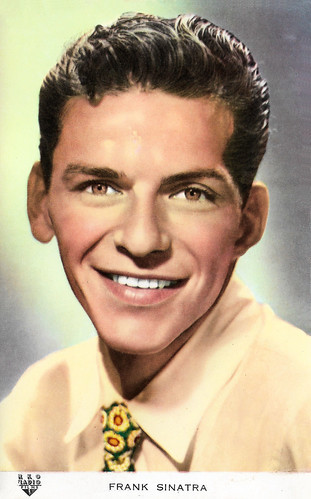
Belgian postcard by N.V. Victoria, Brussels, no. 639 / 21. Photo: RKO Radio Films.
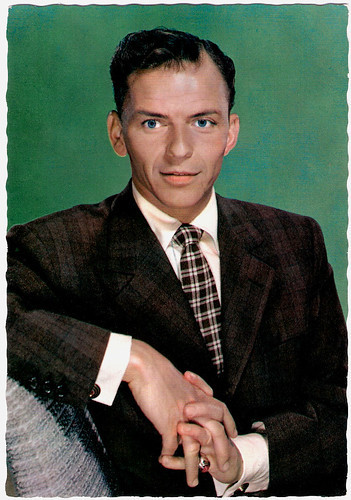
French postcard, no. 113.
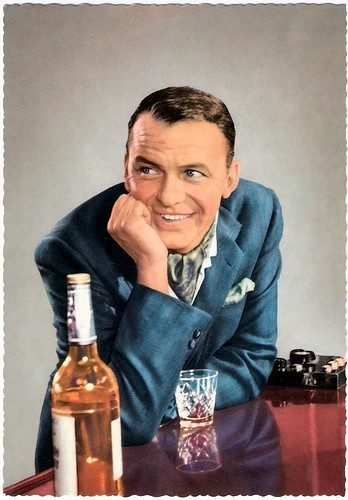
German postcard by Krüger, nr. 902/253.
The idol of the bobby soxers
Francis Albert Sinatra was born to Italian immigrants in Hoboken, New Jersey, in 1915.
Sinatra spent much time at his parents' tavern in Hoboken, working on his homework and occasionally singing a song on top of the player piano for spare change. While he never learned how to read music, Sinatra had an impressive understanding of it, and he worked very hard from a young age to improve his abilities in all aspects of music.
He began his musical career in the swing era with bandleaders Harry James and Tommy Dorsey. Sinatra's first vocal hit was the song 'Polka Dots and Moonbeams' in 1940. 'Imagination' was Sinatra's first top-10 hit. His fourth chart appearance in 1940 was 'I'll Never Smile Again', topping the charts for twelve weeks beginning in mid-July.
Sinatra made his film debut in 1941, performing in an uncredited sequence in Las Vegas Nights (Ralph Murphy, 1941), singing 'I'll Never Smile Again' with Tommy Dorsey's Pied Pipers. As his success and popularity grew, Sinatra pushed Dorsey to allow him to record some solo songs.
In 1942, Sinatra recorded 'Night and Day', 'The Night We Called It a Day', 'The Song is You', and 'Lamplighter's Serenade'. He found success as a solo artist after he signed with Columbia Records in 1943, becoming the idol of the 'bobby soxers'.
In 1945, Metro-Goldwyn-Mayer cast Sinatra opposite Gene Kelly and Kathryn Grayson in the Technicolor musical Anchors Aweigh (George Sidney, 1945), in which he played a sailor on leave in Hollywood for four days. A major success, it garnered several Academy Award wins and nominations, and the song 'I Fall in Love Too Easily', sung by Sinatra in the film, was nominated for the Academy Award for Best Original Song.
Sinatra was awarded a special Oscar for his part in a short film that spoke out against intolerance, The House I Live In (Mervyn LeRoy, 1945). In 1946, he released his debut album, 'The Voice of Frank Sinatra', which reached No. 1 on the Billboard chart.
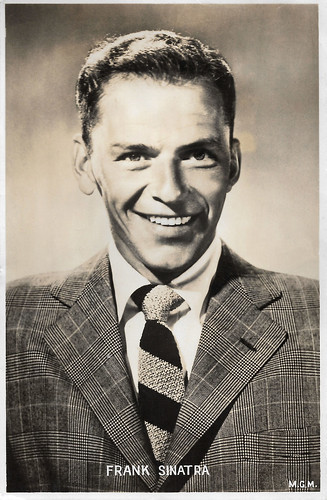
British Real Photograph postcard. Photo: Metro-Goldwyn-Mayer (MGM).
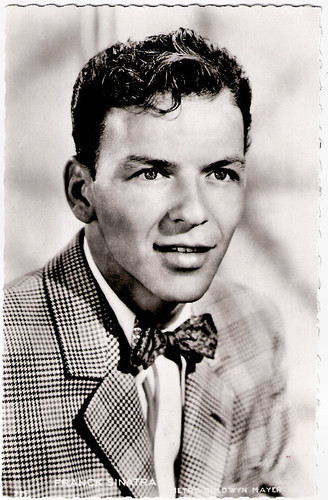
French postcard by Editions P.I., offered by Les Carbones Korès, no. 24 D, 1951. Photo: Metro-Goldwyn-Mayer (MGM).
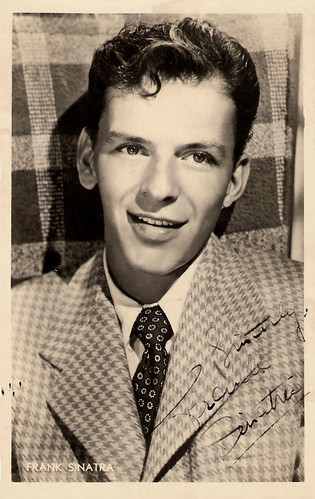
Dutch postcard by S. & v. H., A. Photo: M.P.E.A.
Las Vegas
By the early 1950s, Frank Sinatra's professional career had stalled and he turned to Las Vegas, where he became one of its best known residency performers as part of the Rat Pack.
His career was reborn in 1953 with the success of the film From Here to Eternity (Fred Zinnemann, 1953). The film deals with the tribulations of three U.S. Army soldiers, played by Burt Lancaster , Montgomery Clift, and Frank Sinatra, stationed on Hawaii in the months leading up to the attack on Pearl Harbor. Sinatra won an Oscar and Golden Globe Award for Best Supporting Actor.
In the following years, Sinatra released several critically lauded albums, including 'In the Wee Small Hours' (1955), 'Songs for Swingin' Lovers!' (1956), 'Come Fly with Me' (1958), 'Only the Lonely' (1958) and 'Nice 'n' Easy' (1960).
Sinatra left Capitol in 1960 to start his own record label, Reprise Records, and released a string of successful albums. In 1965, he recorded the retrospective' September of My Years' and starred in the Emmy-winning television special Frank Sinatra: A Man and His Music. He then released 'Sinatra at the Sands', recorded at the Sands Hotel and Casino in Vegas with frequent collaborator Count Basie in early 1966.
The following year he recorded one of his most famous collaborations with Tom Jobim, the album 'Francis Albert Sinatra & Antonio Carlos Jobim'. It was followed by 1968's 'Francis A. & Edward K. with Duke Ellington'.
Sinatra retired for the first time in 1971, but came out of retirement two years later and recorded several albums and resumed performing at Caesars Palace, and reached success in 1980 with 'New York, New York'. Using his Las Vegas shows as a home base, he toured both within the United States and internationally until shortly before his death in 1998.
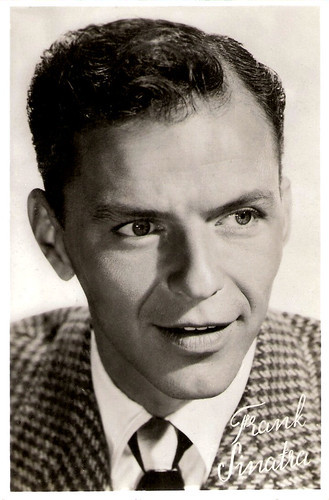
Dutch postcard. Photo: MGM.
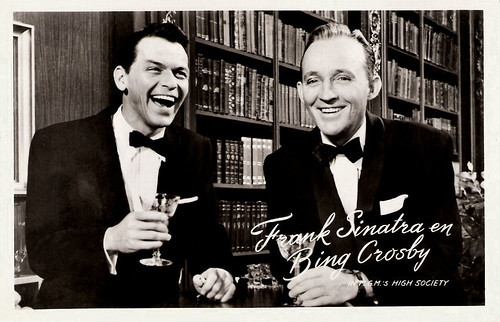
Dutch postcard by Uitg. Takken, Utrecht, no. 3020. Photo: MGM. Frank Sinatra and Bing Crosby in High Society (Charles Walters, 1956).
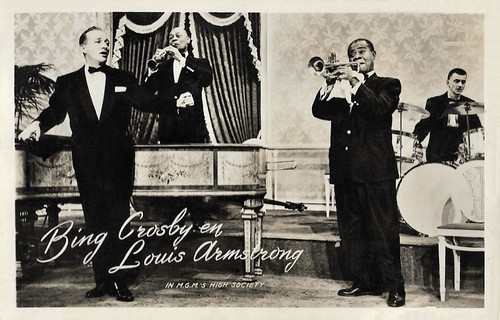
Dutch postcard by Uitg. Takken, Utrecht, no. 3024. Photo: MGM. Bing Crosby and Louis Armstrong in High Society (Charles Walters, 1956).
A colourful personal life
Frank Sinatra forged a highly successful career as a film actor. After winning an Academy Award for From Here to Eternity (Fred Zinnemann, 1953), Sinatra starred opposite Doris Day in the musical Young at Heart (Gordon Douglas, 1954) and earned critical praise for his performance as a psychopathic killer posing as an FBI agent opposite Sterling Hayden in the Film Noir Suddenly (Lewis Allen, 1954).
He played a heroin addict in The Man with the Golden Arm (Otto Preminger, 1955), and was nominated for an Oscar and a BAFTA Award. He appeared in various musicals such as Guys and Dolls (Joseph L. Mankiewicz, 1955) starring Marlon Brando and Jean Simmons , High Society (Charles Walters, 1956) alongside Bing Crosby and Grace Kelly, and Pal Joey (George Sidney, 1957) with Kim Novak and Rita Hayworth , winning another Golden Globe for the latter.
Lighter roles alongside 'Rat Pack' buddies Dean Martin and Sammy Davis Jr. were lucrative, especially the famed Ocean's Eleven (Lewis Milestone, 1960). He again received critical acclaim for his performance opposite Laurence Harvey in The Manchurian Candidate (John Frankenheimer, 1962).
Toward the end of his career, he became associated with playing detectives, including the title character in Tony Rome (Gordon Douglas, 1967), an example of a late-1960s Neo-Noir trend which revived and updated the hard-boiled detective and police dramas of the 1940s. On television, The Frank Sinatra Show began on ABC in 1950, and he continued to make appearances on television throughout the 1950s and 1960s.
Sinatra was also heavily involved with politics from the mid-1940s, and actively campaigned for presidents such as Harry S. Truman, John F. Kennedy and Ronald Reagan. In crime, Sinatra was investigated by the FBI for his alleged relationship with the Mafia. 'Ol' Blue Eyes' led a colourful personal life, and was often involved in turbulent affairs with women.
Sinatra had three children, Nancy (1940), Frank Jr. (1944–2016), and Tina (1948) with his first wife, Nancy Sinatra (née Barbato), to whom he was married from 1939 to 1951. His second marriage to Ava Gardner , from 1951 to 1957, was turbulent with many well-publicised fights and altercations. In 1963 his son Frank Sinatra Jr. was kidnapped. The kidnappers told Frank Sr. to call them from pay phones. He paid the $250,000 ransom, Frank Jr. was returned, and the kidnappers were eventually caught. He married Mia Farrow in 1966 and they divorced in 1968. Sinatra finally was married to Barbara Marx from 1976 until his death.
Frank Sinatra died at Cedars-Sinai Medical Center in Los Angeles in 1998, after a heart attack. He was 82.
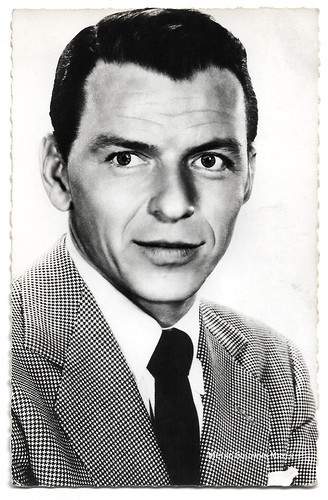
French postcard by Editions du Globe, no. 525. Photo: Metro-Goldwyn-Mayer (MGM).
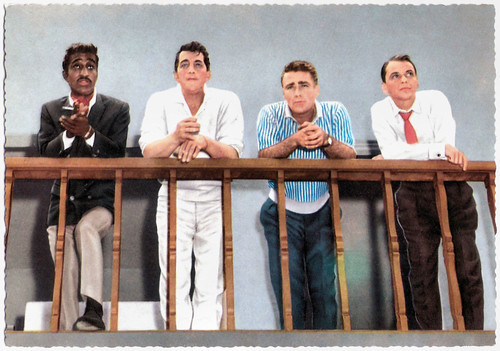
German postcard by Krüger, no. 902/193. Photo: Terb Agency. Sammy Davis Jr., Dean Martin, Peter Lawford and Frank Sinatra
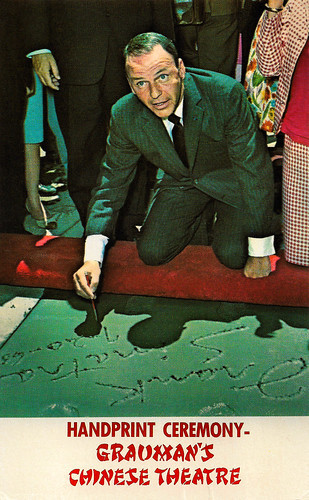
American postcard in the Plastichrome Series by Colourpicture, Boston, Mass., no. P67559. Captions: Handprint Ceremony Grauman's Chinese Theatre. Frank Sinatra being immortalized in the forecourt at Grauman's Chinese Theatre, Hollywood, California.
Sources: Wikipedia and .

Belgian postcard by N.V. Victoria, Brussels, no. 639 / 21. Photo: RKO Radio Films.

French postcard, no. 113.

German postcard by Krüger, nr. 902/253.
The idol of the bobby soxers
Francis Albert Sinatra was born to Italian immigrants in Hoboken, New Jersey, in 1915.
Sinatra spent much time at his parents' tavern in Hoboken, working on his homework and occasionally singing a song on top of the player piano for spare change. While he never learned how to read music, Sinatra had an impressive understanding of it, and he worked very hard from a young age to improve his abilities in all aspects of music.
He began his musical career in the swing era with bandleaders Harry James and Tommy Dorsey. Sinatra's first vocal hit was the song 'Polka Dots and Moonbeams' in 1940. 'Imagination' was Sinatra's first top-10 hit. His fourth chart appearance in 1940 was 'I'll Never Smile Again', topping the charts for twelve weeks beginning in mid-July.
Sinatra made his film debut in 1941, performing in an uncredited sequence in Las Vegas Nights (Ralph Murphy, 1941), singing 'I'll Never Smile Again' with Tommy Dorsey's Pied Pipers. As his success and popularity grew, Sinatra pushed Dorsey to allow him to record some solo songs.
In 1942, Sinatra recorded 'Night and Day', 'The Night We Called It a Day', 'The Song is You', and 'Lamplighter's Serenade'. He found success as a solo artist after he signed with Columbia Records in 1943, becoming the idol of the 'bobby soxers'.
In 1945, Metro-Goldwyn-Mayer cast Sinatra opposite Gene Kelly and Kathryn Grayson in the Technicolor musical Anchors Aweigh (George Sidney, 1945), in which he played a sailor on leave in Hollywood for four days. A major success, it garnered several Academy Award wins and nominations, and the song 'I Fall in Love Too Easily', sung by Sinatra in the film, was nominated for the Academy Award for Best Original Song.
Sinatra was awarded a special Oscar for his part in a short film that spoke out against intolerance, The House I Live In (Mervyn LeRoy, 1945). In 1946, he released his debut album, 'The Voice of Frank Sinatra', which reached No. 1 on the Billboard chart.

British Real Photograph postcard. Photo: Metro-Goldwyn-Mayer (MGM).

French postcard by Editions P.I., offered by Les Carbones Korès, no. 24 D, 1951. Photo: Metro-Goldwyn-Mayer (MGM).

Dutch postcard by S. & v. H., A. Photo: M.P.E.A.
Las Vegas
By the early 1950s, Frank Sinatra's professional career had stalled and he turned to Las Vegas, where he became one of its best known residency performers as part of the Rat Pack.
His career was reborn in 1953 with the success of the film From Here to Eternity (Fred Zinnemann, 1953). The film deals with the tribulations of three U.S. Army soldiers, played by Burt Lancaster , Montgomery Clift, and Frank Sinatra, stationed on Hawaii in the months leading up to the attack on Pearl Harbor. Sinatra won an Oscar and Golden Globe Award for Best Supporting Actor.
In the following years, Sinatra released several critically lauded albums, including 'In the Wee Small Hours' (1955), 'Songs for Swingin' Lovers!' (1956), 'Come Fly with Me' (1958), 'Only the Lonely' (1958) and 'Nice 'n' Easy' (1960).
Sinatra left Capitol in 1960 to start his own record label, Reprise Records, and released a string of successful albums. In 1965, he recorded the retrospective' September of My Years' and starred in the Emmy-winning television special Frank Sinatra: A Man and His Music. He then released 'Sinatra at the Sands', recorded at the Sands Hotel and Casino in Vegas with frequent collaborator Count Basie in early 1966.
The following year he recorded one of his most famous collaborations with Tom Jobim, the album 'Francis Albert Sinatra & Antonio Carlos Jobim'. It was followed by 1968's 'Francis A. & Edward K. with Duke Ellington'.
Sinatra retired for the first time in 1971, but came out of retirement two years later and recorded several albums and resumed performing at Caesars Palace, and reached success in 1980 with 'New York, New York'. Using his Las Vegas shows as a home base, he toured both within the United States and internationally until shortly before his death in 1998.

Dutch postcard. Photo: MGM.

Dutch postcard by Uitg. Takken, Utrecht, no. 3020. Photo: MGM. Frank Sinatra and Bing Crosby in High Society (Charles Walters, 1956).

Dutch postcard by Uitg. Takken, Utrecht, no. 3024. Photo: MGM. Bing Crosby and Louis Armstrong in High Society (Charles Walters, 1956).
A colourful personal life
Frank Sinatra forged a highly successful career as a film actor. After winning an Academy Award for From Here to Eternity (Fred Zinnemann, 1953), Sinatra starred opposite Doris Day in the musical Young at Heart (Gordon Douglas, 1954) and earned critical praise for his performance as a psychopathic killer posing as an FBI agent opposite Sterling Hayden in the Film Noir Suddenly (Lewis Allen, 1954).
He played a heroin addict in The Man with the Golden Arm (Otto Preminger, 1955), and was nominated for an Oscar and a BAFTA Award. He appeared in various musicals such as Guys and Dolls (Joseph L. Mankiewicz, 1955) starring Marlon Brando and Jean Simmons , High Society (Charles Walters, 1956) alongside Bing Crosby and Grace Kelly, and Pal Joey (George Sidney, 1957) with Kim Novak and Rita Hayworth , winning another Golden Globe for the latter.
Lighter roles alongside 'Rat Pack' buddies Dean Martin and Sammy Davis Jr. were lucrative, especially the famed Ocean's Eleven (Lewis Milestone, 1960). He again received critical acclaim for his performance opposite Laurence Harvey in The Manchurian Candidate (John Frankenheimer, 1962).
Toward the end of his career, he became associated with playing detectives, including the title character in Tony Rome (Gordon Douglas, 1967), an example of a late-1960s Neo-Noir trend which revived and updated the hard-boiled detective and police dramas of the 1940s. On television, The Frank Sinatra Show began on ABC in 1950, and he continued to make appearances on television throughout the 1950s and 1960s.
Sinatra was also heavily involved with politics from the mid-1940s, and actively campaigned for presidents such as Harry S. Truman, John F. Kennedy and Ronald Reagan. In crime, Sinatra was investigated by the FBI for his alleged relationship with the Mafia. 'Ol' Blue Eyes' led a colourful personal life, and was often involved in turbulent affairs with women.
Sinatra had three children, Nancy (1940), Frank Jr. (1944–2016), and Tina (1948) with his first wife, Nancy Sinatra (née Barbato), to whom he was married from 1939 to 1951. His second marriage to Ava Gardner , from 1951 to 1957, was turbulent with many well-publicised fights and altercations. In 1963 his son Frank Sinatra Jr. was kidnapped. The kidnappers told Frank Sr. to call them from pay phones. He paid the $250,000 ransom, Frank Jr. was returned, and the kidnappers were eventually caught. He married Mia Farrow in 1966 and they divorced in 1968. Sinatra finally was married to Barbara Marx from 1976 until his death.
Frank Sinatra died at Cedars-Sinai Medical Center in Los Angeles in 1998, after a heart attack. He was 82.

French postcard by Editions du Globe, no. 525. Photo: Metro-Goldwyn-Mayer (MGM).

German postcard by Krüger, no. 902/193. Photo: Terb Agency. Sammy Davis Jr., Dean Martin, Peter Lawford and Frank Sinatra

American postcard in the Plastichrome Series by Colourpicture, Boston, Mass., no. P67559. Captions: Handprint Ceremony Grauman's Chinese Theatre. Frank Sinatra being immortalized in the forecourt at Grauman's Chinese Theatre, Hollywood, California.
Sources: Wikipedia and .
Published on December 26, 2019 22:00
December 25, 2019
Yvette Lebon
French actress Yvette Lebon (1910-2014) appeared in 39 films between 1931 and 1972. Her beautiful eyes made her one of the most attractive faces of the French cinema of the 1930s.
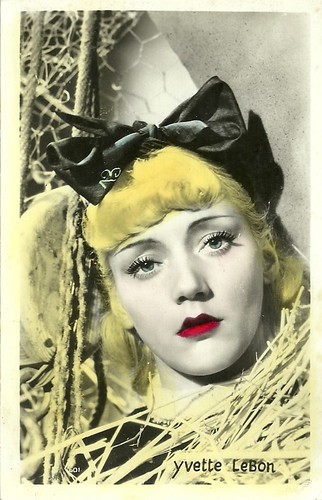
French postcard by unknown editor, no. 601.
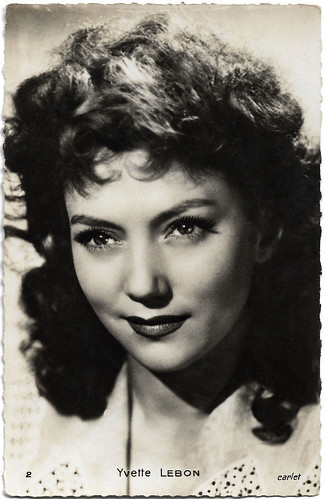
French postcard, no. 2. Photo: Carlet.
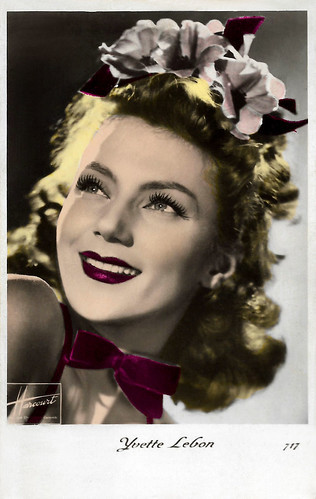
French postcard, Paris, no. 717. Photo: Studio Harcourt.
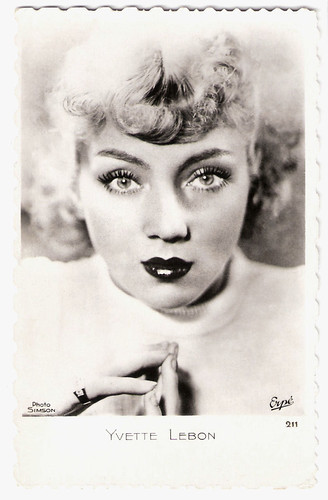
French postcard by Erpé, no. 211. Photo: Simson.
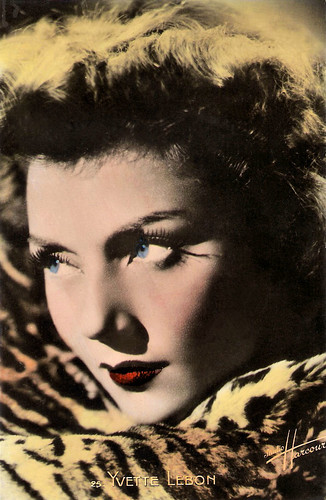
French postcard by Editions S.E.R.P, Paris, no. 25. Photo: Studio Harcourt.
Love Interest
Yvette Lebon was born as Simone Lebon in Paris in 1910. She was a close relation of stage and film director Sacha Guitry .
Her film career started in 1931 with a small part in the romantic comedy Rive gauche/Left Bank (Alexander Korda, 1931) starring Meg Lemonnier . This was an alternative language version of the Paramount production Laughter (Harry d'Abbadie d'Arrast, 1930) starring Nancy Carroll .
Director Marc Allégret spotted her during an audition and gave her a supporting part in the musical Zouzou/Zou Zou (Marc Allégret, 1934) starring Josephine Baker .
Among Lebon’s other early films were the comedy Le Chéri de sa concierge/The Darling Of Her Caretaker (Giuseppe Guarino, 1934) with the young Fernandel , Divine (Max Ophüls, 1935) and the big hit Marinella (Pierre Caron, 1936) in which she played the love interest of popular singer Tino Rossi .
Her first leading role was in Les Mariages de Mademoiselle Lévy/Miss Levy's marriages (André Hugon, 1936).
The following years she appeared in the historical adventure film Michel Strogoff/Michael Strogoff (Jacques de Baroncelli, Richard Eichberg, 1936) featuring Adolf Wohlbruck (aka Anton Walbrook), the drama Abus de confiance/Abused Confidence (Henri Decoin, 1937) with Danielle Darrieux and Charles Vanel , and the war drama Gibraltar (Fyodor Otsep, 1938) starring Viviane Romance and Roger Duchesne . Duchesne became her first husband.
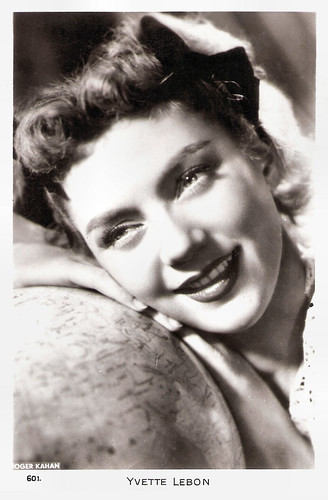
French postcard by Editions Chantal, Paris, no. 601. Photo: Roger Kahan.
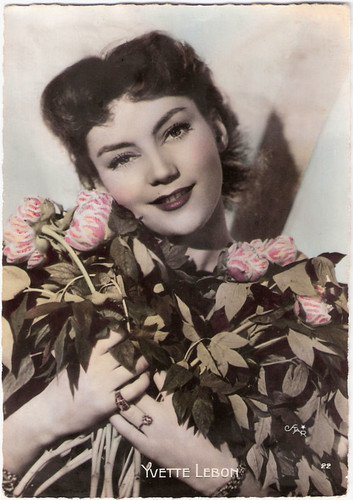
French postcard by Editions O.P., Paris, no. 22. Photo: Star.
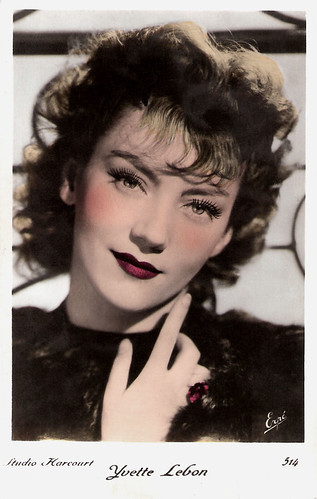
French postcard by Erpé, no. 514. Photo: Studio Harcourt.
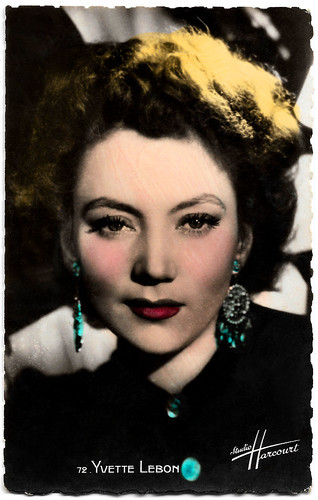
French postcard by S.E.R.P., Paris, no. 72. Photo: Studio Harcourt.
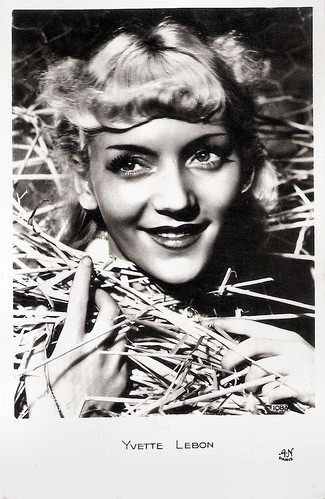
French postcard by A.N., Paris, no. 1083.
103rd Birthday
During the war years Yvette Lebon played in the comedy L'Homme qui cherche la vérité/The Man Who Looks for The Truth (Alexander Esway, 1940) with Raimu, the historical comedy-drama Le destin fabuleux de Désirée Clary/Mlle. Desiree (1942), directed by and starring her relative Sacha Guitry as Napoleon, and another historical film, Paméla (Pierre de Hérain, 1945) with Fernand Gravey and Renée Saint-Cyr .
At the time she was the mistress of journalist and politician Jean Luchaire. With his evening daily Les Nouveaux Temps, Luchaire supported the Vichy regime's Révolution nationale in 1940. In 1946 he was tried and executed.
After the war, Lebon could be seen in Monsieur Grégoire s'évade/Mr. Gregoire Runs Away (Jacques Daniel-Norman, 1946) with Bernard Blier , and Les Amours de Blanche Neige/The Loves Of Snow White (Edi Wieser, 1947).
From the 1950s on, she also performed for the Italian and Spanish cinema. Her international films include the adventure film Il boia di Lilla/Milady and the Musketeers (Vittorio Cottafavi, 1952) in which she played one of her best roles as Milady the Winter opposite Rossano Brazzi , the musical comedy Maruzzella (Luigi Capuano, 1956) featuring Marisa Allasio , and the Peplum Ulisse contro Ercole/Ulysses Against the Son of Hercules (Mario Caiano, 1962) starring Georges Marchal .
Her last appearance was in the film Je, tu, elles.../I, You, They (Peter Foldes, 1972). Yvette Lebon was married twice, first to actor Roger Duchesne and then to Belgian-American producer Nathan ‘Nat’ Wachsberger, till his death in 1992. Wachsberger produced some of the later films she appeared in, including La cavale/On the Lam (Michel Mitrani, 1971) with Juliet Berto.
Their son Patrick Wachsberger is also a producer, and on his resume are Mr. And Mrs. Smith (Doug Liman, 2005) with Brad Pitt and Angelina Jolie, and Letters to Juliet (Gary Winick, 2010) with Amanda Seyfried and Gael García Bernal.
Yvette Lebon died in 2014 in Cannes, France. Lebon had turned 103 in August 2013, and was France's oldest surviving actress until her death. She is interred at the Forest Lawn Memorial Park in Hollywood Hills.
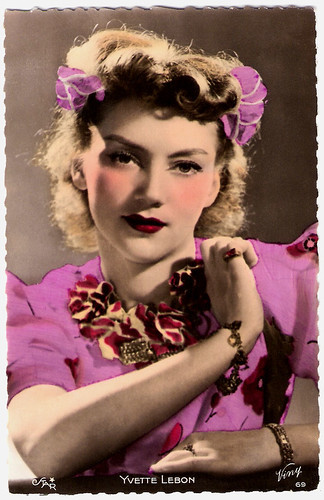
French postcard by Viny, no. 69. Photo: Star.
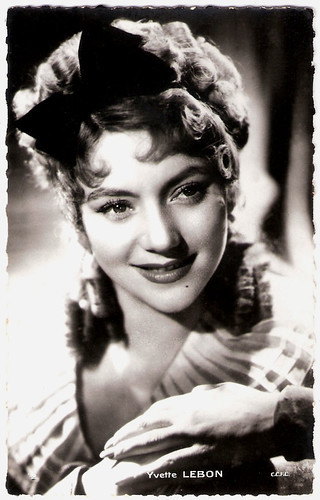
French postcard by Editions Chantal, Rueil, no. 2. Photo: C.C.F.C.
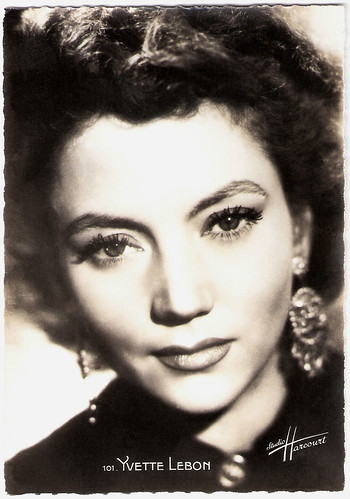
French postcard, no. 101. Photo: Studio Harcourt, Paris.
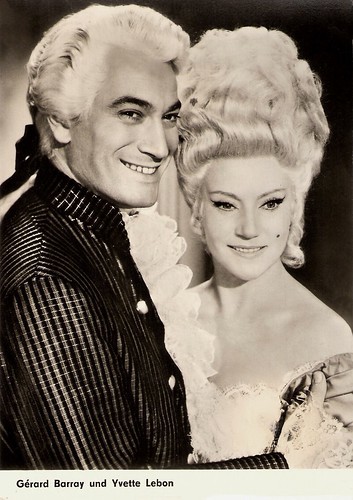
East-German postcard by Progress Film-Verleih, Berlin, no. 3034, 1968. Photo: publicity still for La máscara de Scaramouche/The Adventures of Scaramouche (Antonio Isasi-Isasmendi, 1963).
Sources: Music Man (Movie-Musical-World - French), Les légendes du cinéma (French), L'@ide-Mémoire (French), Wikipedia (English and French), and .

French postcard by unknown editor, no. 601.

French postcard, no. 2. Photo: Carlet.

French postcard, Paris, no. 717. Photo: Studio Harcourt.

French postcard by Erpé, no. 211. Photo: Simson.

French postcard by Editions S.E.R.P, Paris, no. 25. Photo: Studio Harcourt.
Love Interest
Yvette Lebon was born as Simone Lebon in Paris in 1910. She was a close relation of stage and film director Sacha Guitry .
Her film career started in 1931 with a small part in the romantic comedy Rive gauche/Left Bank (Alexander Korda, 1931) starring Meg Lemonnier . This was an alternative language version of the Paramount production Laughter (Harry d'Abbadie d'Arrast, 1930) starring Nancy Carroll .
Director Marc Allégret spotted her during an audition and gave her a supporting part in the musical Zouzou/Zou Zou (Marc Allégret, 1934) starring Josephine Baker .
Among Lebon’s other early films were the comedy Le Chéri de sa concierge/The Darling Of Her Caretaker (Giuseppe Guarino, 1934) with the young Fernandel , Divine (Max Ophüls, 1935) and the big hit Marinella (Pierre Caron, 1936) in which she played the love interest of popular singer Tino Rossi .
Her first leading role was in Les Mariages de Mademoiselle Lévy/Miss Levy's marriages (André Hugon, 1936).
The following years she appeared in the historical adventure film Michel Strogoff/Michael Strogoff (Jacques de Baroncelli, Richard Eichberg, 1936) featuring Adolf Wohlbruck (aka Anton Walbrook), the drama Abus de confiance/Abused Confidence (Henri Decoin, 1937) with Danielle Darrieux and Charles Vanel , and the war drama Gibraltar (Fyodor Otsep, 1938) starring Viviane Romance and Roger Duchesne . Duchesne became her first husband.

French postcard by Editions Chantal, Paris, no. 601. Photo: Roger Kahan.

French postcard by Editions O.P., Paris, no. 22. Photo: Star.

French postcard by Erpé, no. 514. Photo: Studio Harcourt.

French postcard by S.E.R.P., Paris, no. 72. Photo: Studio Harcourt.

French postcard by A.N., Paris, no. 1083.
103rd Birthday
During the war years Yvette Lebon played in the comedy L'Homme qui cherche la vérité/The Man Who Looks for The Truth (Alexander Esway, 1940) with Raimu, the historical comedy-drama Le destin fabuleux de Désirée Clary/Mlle. Desiree (1942), directed by and starring her relative Sacha Guitry as Napoleon, and another historical film, Paméla (Pierre de Hérain, 1945) with Fernand Gravey and Renée Saint-Cyr .
At the time she was the mistress of journalist and politician Jean Luchaire. With his evening daily Les Nouveaux Temps, Luchaire supported the Vichy regime's Révolution nationale in 1940. In 1946 he was tried and executed.
After the war, Lebon could be seen in Monsieur Grégoire s'évade/Mr. Gregoire Runs Away (Jacques Daniel-Norman, 1946) with Bernard Blier , and Les Amours de Blanche Neige/The Loves Of Snow White (Edi Wieser, 1947).
From the 1950s on, she also performed for the Italian and Spanish cinema. Her international films include the adventure film Il boia di Lilla/Milady and the Musketeers (Vittorio Cottafavi, 1952) in which she played one of her best roles as Milady the Winter opposite Rossano Brazzi , the musical comedy Maruzzella (Luigi Capuano, 1956) featuring Marisa Allasio , and the Peplum Ulisse contro Ercole/Ulysses Against the Son of Hercules (Mario Caiano, 1962) starring Georges Marchal .
Her last appearance was in the film Je, tu, elles.../I, You, They (Peter Foldes, 1972). Yvette Lebon was married twice, first to actor Roger Duchesne and then to Belgian-American producer Nathan ‘Nat’ Wachsberger, till his death in 1992. Wachsberger produced some of the later films she appeared in, including La cavale/On the Lam (Michel Mitrani, 1971) with Juliet Berto.
Their son Patrick Wachsberger is also a producer, and on his resume are Mr. And Mrs. Smith (Doug Liman, 2005) with Brad Pitt and Angelina Jolie, and Letters to Juliet (Gary Winick, 2010) with Amanda Seyfried and Gael García Bernal.
Yvette Lebon died in 2014 in Cannes, France. Lebon had turned 103 in August 2013, and was France's oldest surviving actress until her death. She is interred at the Forest Lawn Memorial Park in Hollywood Hills.

French postcard by Viny, no. 69. Photo: Star.

French postcard by Editions Chantal, Rueil, no. 2. Photo: C.C.F.C.

French postcard, no. 101. Photo: Studio Harcourt, Paris.

East-German postcard by Progress Film-Verleih, Berlin, no. 3034, 1968. Photo: publicity still for La máscara de Scaramouche/The Adventures of Scaramouche (Antonio Isasi-Isasmendi, 1963).
Sources: Music Man (Movie-Musical-World - French), Les légendes du cinéma (French), L'@ide-Mémoire (French), Wikipedia (English and French), and .
Published on December 25, 2019 22:00
December 24, 2019
Merry Christmas!
As every year: Gelukkig kerstfeest! Frohe Weihnachten! ¡Feliz Navidad! Joyeux Noël! Buon Natale! Sretan Božić! Καλά Χριστούγεννα! Boldog karácsonyt! Gleðileg jól! Nollaig Shona! Priecīgus Ziemassvētkus! Linksmų Kalėdų! Среќен Божиќ God jul! Wesołych Świąt! Feliz Natal! Crăciun fericit! С Рождеством Срећан Божић veselé Vianoce! Vesel božič! God Jul! Nadolig Llawen! Gëzuar Krishtlindjet! Eguberri! Merry Christmas!
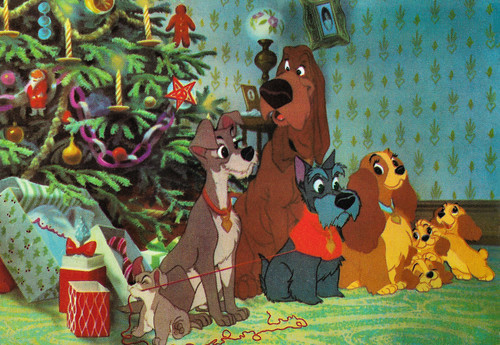
French postcard by Editions Crès, Paris, no. 202, 1964. Caption: The Reunion. Image: Walt Disney Productions. Publicity still for Lady and the Tramp (Clyde Geronimi, Wilfred Jackson, Hamilton Luske, 1955).
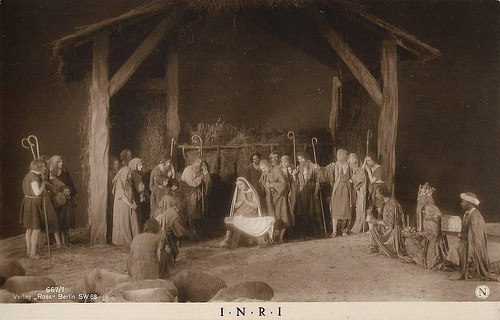
German postcard. Ross Verlag, no. 667/1. Photo: Neumann. The Nativity Scene with Henny Porten as Mary in the Biblical film I.N.R.I. (Robert Wiene, 1923).
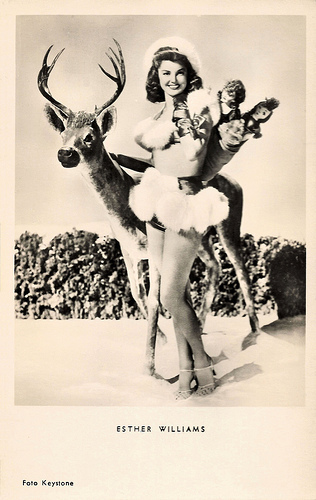
Esther Williams. German postcard by Kunst und Bild, Berlin, no. A 190. Photo: Keystone.
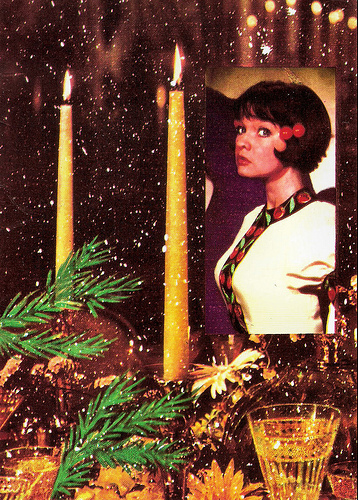
Margareta Pislaru . Romanian postcard by Casa Filmului Acin.
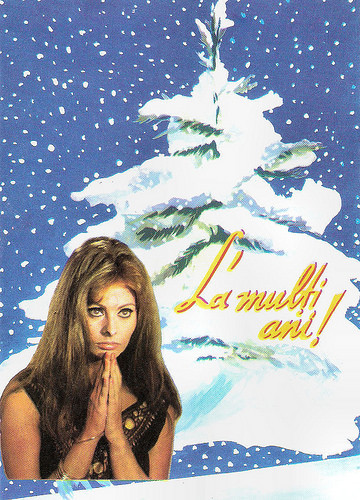
Sophia Loren . Romanian postcard by Casa Filmului Acin.
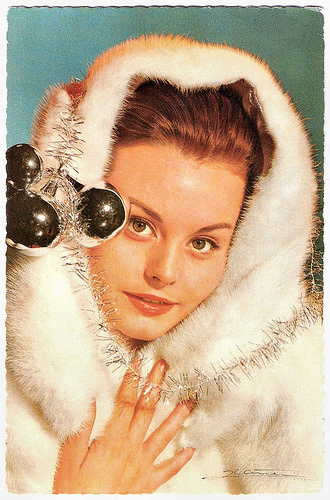
Rocío Dúrcal . Spanish postcard by Ediciones Tarjet-Fher / Ediciones Mandolina, no. 216. Photo: Epoca Films.
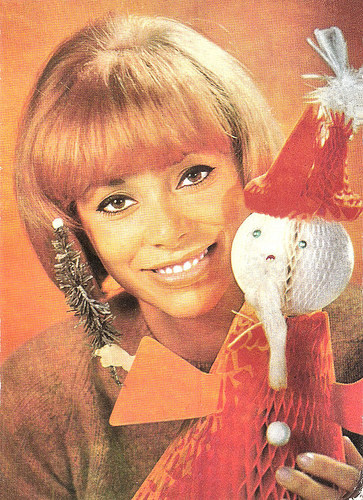
Mireille Darc . Romanian postcard by Casa Filmului Acin, no. 436.
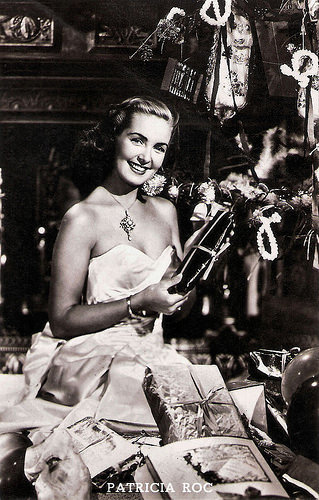
Patricia Roc . Dutch postcard. Photo: British Lion.
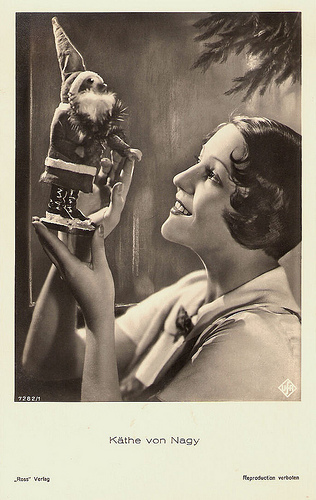
Käthe von Nagy . German postcard by Ross Verlag, no. 7282/1. Photo: Ufa. Released in Italy by Ed. Ballerini & Fratini, Firenze.
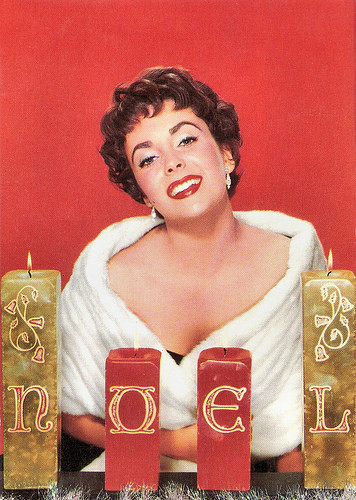
Elizabeth Taylor . French postcard by Editions P.I., Paris, no. 1051. Photo: John Everton / Ufa.
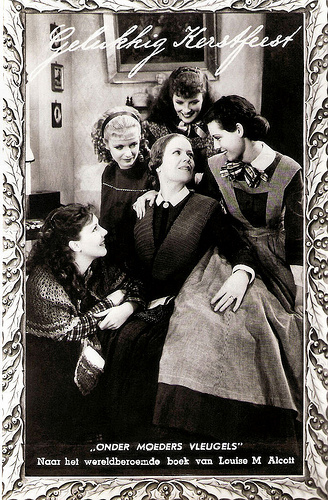
Dutch postcard by the Rialto Theatre, Amsterdam, 1934. Photo: Remaco Radio Picture. Publicity still for Little Women (George Cukor, 1933). In the picture are Katharine Hepburn , Joan Bennett, Frances Dee, Jean Parker and Spring Byington. The Dutch title of the film and the book by Louise M. Alcott is Onder moeders vleugels.
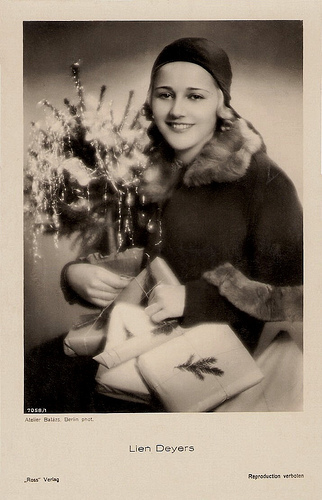
Lien Deyers . German postcard by Ross Verlag, no. 7058/1, 1932-1933. Photo: Atelier Balász, Berlin.
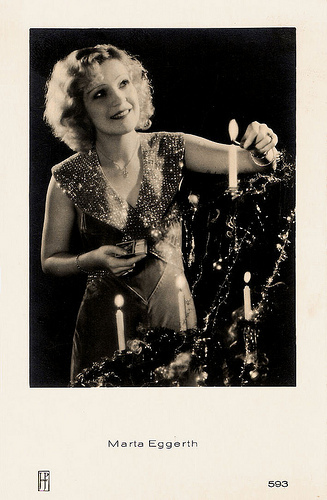
Marta Eggerth . Dutch postcard by JosPe, no. 593.
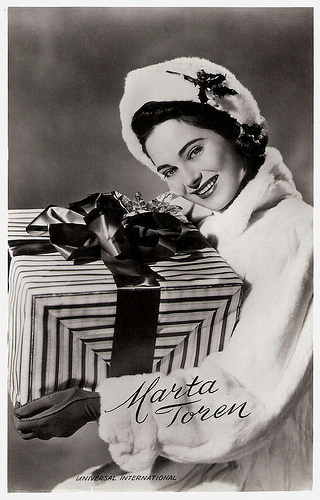
Marta Toren . Dutch postcard, no. 3374. Photo: Universal International / Fotoarchief Film en Toneel.
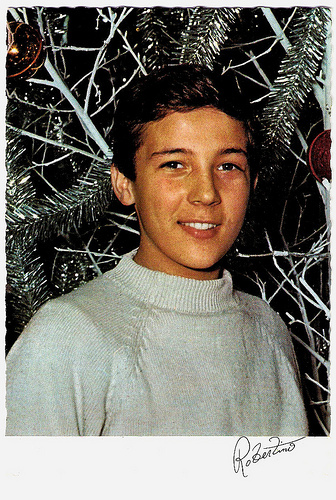
Robertino . French postcard by Editions Publistar, Marseille, no. 811. Photo: President.

Kermit. Dutch postcard by Interstat, Amsterdam. Photo: The Jim Henson Company.
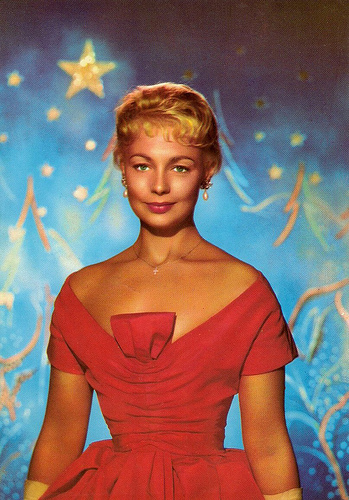
Dany Robin . French postcard by Editions P.I., Paris, no. 1004. Photo: Sam Lévin.
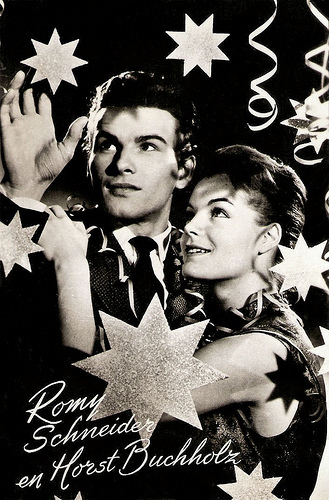
Romy Schneider & Horst Buchholz . Dutch postcard by Uitg. Takken, Utrecht, no. 3572.
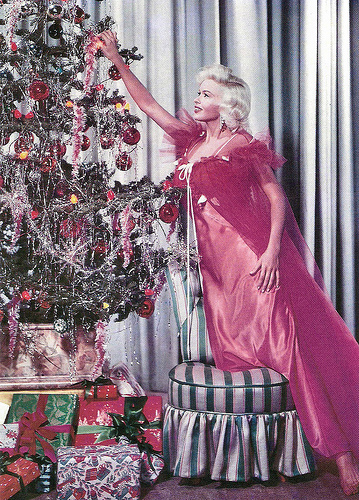
Jayne Mansfield. French postcard by Edition a la carte. Photo: Filmhistorisches Bildarchiv Peter W. Engelmeier.
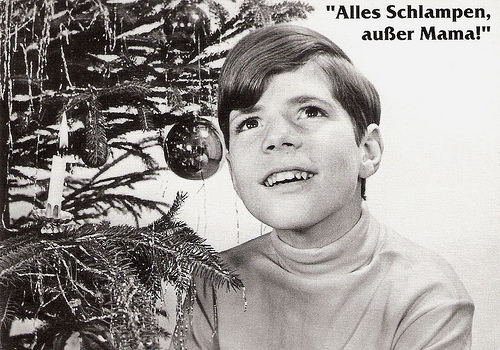
Heintje Simons . German postcard by Modern Times. Photo: Interfoto. Caption: Alles schlampen, ausser mama (All bitches, except mama).
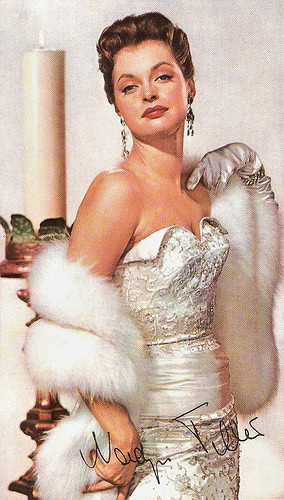
Nadja Tiller . German promotion card for Luxor.

German postcard by Rotophot in the Film Sterne series, no. 542/1. Photo: Messter-Film. Publicity still of Viggo Larsen in Der Sohn des Hannibal/The Son of Hannibal (Viggo Larsen, 1918).

French postcard by Editions Crès, Paris, no. 202, 1964. Caption: The Reunion. Image: Walt Disney Productions. Publicity still for Lady and the Tramp (Clyde Geronimi, Wilfred Jackson, Hamilton Luske, 1955).

German postcard. Ross Verlag, no. 667/1. Photo: Neumann. The Nativity Scene with Henny Porten as Mary in the Biblical film I.N.R.I. (Robert Wiene, 1923).

Esther Williams. German postcard by Kunst und Bild, Berlin, no. A 190. Photo: Keystone.

Margareta Pislaru . Romanian postcard by Casa Filmului Acin.

Sophia Loren . Romanian postcard by Casa Filmului Acin.

Rocío Dúrcal . Spanish postcard by Ediciones Tarjet-Fher / Ediciones Mandolina, no. 216. Photo: Epoca Films.

Mireille Darc . Romanian postcard by Casa Filmului Acin, no. 436.

Patricia Roc . Dutch postcard. Photo: British Lion.

Käthe von Nagy . German postcard by Ross Verlag, no. 7282/1. Photo: Ufa. Released in Italy by Ed. Ballerini & Fratini, Firenze.

Elizabeth Taylor . French postcard by Editions P.I., Paris, no. 1051. Photo: John Everton / Ufa.

Dutch postcard by the Rialto Theatre, Amsterdam, 1934. Photo: Remaco Radio Picture. Publicity still for Little Women (George Cukor, 1933). In the picture are Katharine Hepburn , Joan Bennett, Frances Dee, Jean Parker and Spring Byington. The Dutch title of the film and the book by Louise M. Alcott is Onder moeders vleugels.

Lien Deyers . German postcard by Ross Verlag, no. 7058/1, 1932-1933. Photo: Atelier Balász, Berlin.

Marta Eggerth . Dutch postcard by JosPe, no. 593.

Marta Toren . Dutch postcard, no. 3374. Photo: Universal International / Fotoarchief Film en Toneel.

Robertino . French postcard by Editions Publistar, Marseille, no. 811. Photo: President.

Kermit. Dutch postcard by Interstat, Amsterdam. Photo: The Jim Henson Company.

Dany Robin . French postcard by Editions P.I., Paris, no. 1004. Photo: Sam Lévin.

Romy Schneider & Horst Buchholz . Dutch postcard by Uitg. Takken, Utrecht, no. 3572.

Jayne Mansfield. French postcard by Edition a la carte. Photo: Filmhistorisches Bildarchiv Peter W. Engelmeier.

Heintje Simons . German postcard by Modern Times. Photo: Interfoto. Caption: Alles schlampen, ausser mama (All bitches, except mama).

Nadja Tiller . German promotion card for Luxor.

German postcard by Rotophot in the Film Sterne series, no. 542/1. Photo: Messter-Film. Publicity still of Viggo Larsen in Der Sohn des Hannibal/The Son of Hannibal (Viggo Larsen, 1918).
Published on December 24, 2019 22:00
December 23, 2019
Lady and the Tramp (1955)
Walt Disney's animation classic Lady and the Tramp (Clyde Geronimi, Wilfred Jackson, Hamilton Luske, 1955) tells the romantic tale of a pampered uptown cocker spaniel and a streetwise downtown Mutt. It was based on 'Happy Dan, The Cynical Dog,' by Ward Greene. The film offers amongst many other delights one of the most memorable kisses in Hollywood history.
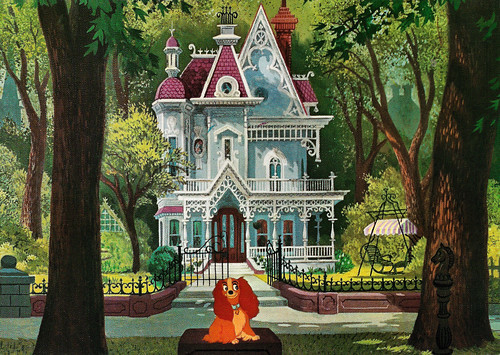
Italian postcard by Grafiche Biondetti S.R.L., Verona, no. 108. Image: Disney. Publicity still for Lady and the Tramp (Clyde Geronimi, Wilfred Jackson, Hamilton Luske, 1955).
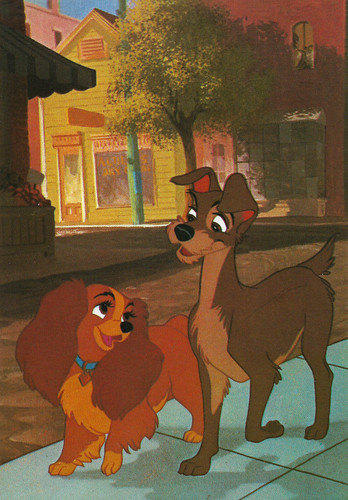
Italian postcard by Grafiche Biondetti S.R.L., Verona, no. 108/3. Image: Disney. Publicity still for Lady and the Tramp (Clyde Geronimi, Wilfred Jackson, Hamilton Luske, 1955).
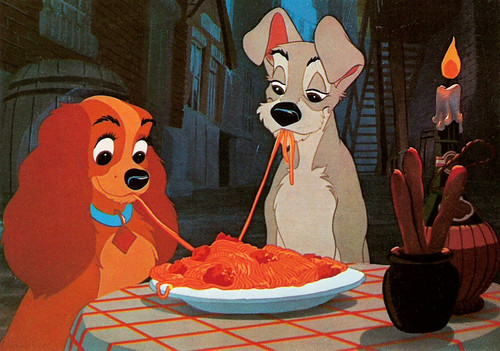
Italian postcard by Grafiche Biondetti S.R.L., Verona, no. 108/4. Image: Disney. Publicity still for Lady and the Tramp (Clyde Geronimi, Wilfred Jackson, Hamilton Luske, 1955).
When a baby moves in, a dog moves out
The story of Lady and the Tramp opens with a cute little American cocker spaniel puppy named Lady offered as a Christmas gift to 'Darling' by her husband Jim 'Dear'. The owners' names, besides the fact that their faces are rarely shown, accentuate the impression that we're watching the film from the dogs' perspectives.
Lady adores her a refined, upper-middle-class surroundings and receives the requited love of her owners. Six months later, that love hasn't diminished and she is a newly licensed pet. Lady has befriended two local neighbourhood dogs, a Scottish terrier named Jock, and a bloodhound named Trusty, suffering a busted sniffer.
But Lady learns that her owners are expecting a child, and suddenly Lady has been unwittingly pushed aside to make room for a new bundle of joy. The upset Lady meets up with a mongrel dog who calls himself the Tramp. He is obviously from the wrong side of the tracks, and Jock and Trusty take an immediate dislike to the stray and order him out of the yard. As Tramp leaves, he reminds Lady that "when a baby moves in, a dog moves out."
When Darling's snooty Aunt Sarah introduces Si and Am, her sneaky twin Siamese cats into the fold, Lady is certain that she's no longer welcome. The cats wreak all manner of havoc, for which Lady is blamed. After the poor dog is fitted with a muzzle, Lady escapes from the house. The Tramp saves Lady from a pack of other street dogs and helps her remove her muzzle. Then he takes her out on a night on the town, culminating in a romantic spaghetti dinner, courtesy of a pair of dog-loving Italian waiters. But her love with him will have bad consequences.
After many adventures, the film ends at Christmas. Tramp has been adopted into the family, and he and Lady have started their own family, with Lady having given birth to a litter of four puppies: three daughters who look identical to Lady and one son who looks identical to Tramp.
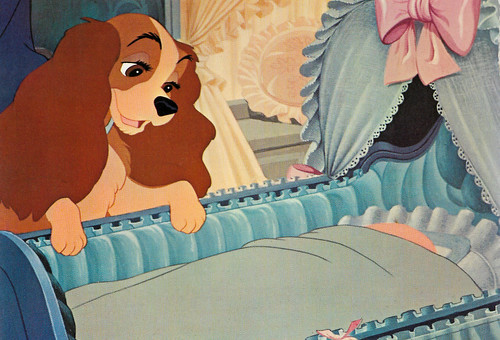
Belgian postcard by Editions Corna. Image: Walt Disney Productions. Publicity still for Lady and the Tramp (Clyde Geronimi, Wilfred Jackson, Hamilton Luske, 1955).
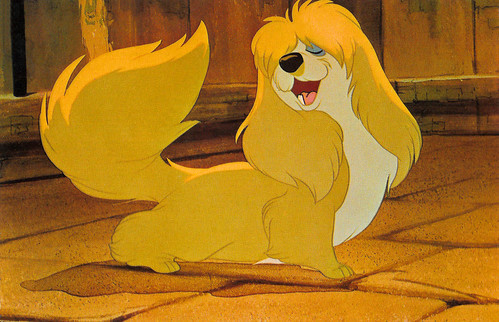
Belgian postcard by Editions Corna. Image: Walt Disney Productions. Publicity still for Lady and the Tramp (Clyde Geronimi, Wilfred Jackson, Hamilton Luske, 1955).
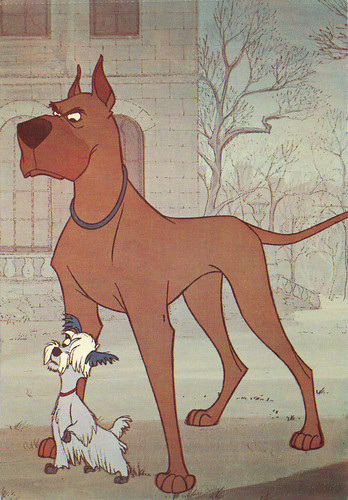
French postcard. Image: Walt Disney Productions. Publicity still for Lady and the Tramp (Clyde Geronimi, Wilfred Jackson, Hamilton Luske, 1955).
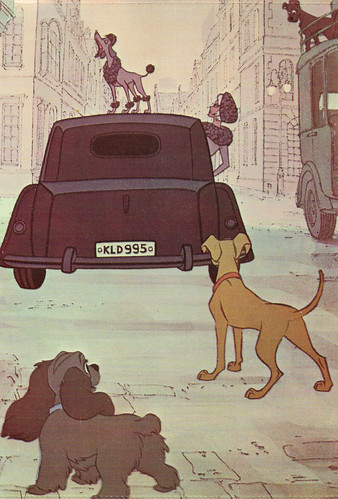
French postcard. Image: Walt Disney Productions. Publicity still for Lady and the Tramp (Clyde Geronimi, Wilfred Jackson, Hamilton Luske, 1955).
Bow-Wow-Wow! - And - Arf! Arf! Arf!
Lady and the Tramp (1955) would be Disney Studios' 15th animated feature film and the first to be produced in wide-screen Cinema-Scope. During the early 1950s Disney made some excellent animated features such as Alice in Wonderland (1951) and Peter Pan (1953), Lady and the Tramp followed those films and proved to be another good film from the studio.
Wikipedia writes that Lady and the Tramp was released to theatres on 22 June 1955 to box office success. "It initially received mixed to negative reviews by film critics, but critical reception for the film has been generally positive in modern times, and the film is now seen as one of the best animated films from Disney." Dave Kehr, writing for The Chicago Tribune gave the film four stars.
Lady and the Tramp is an unpretentious little gem, told from the viewpoint of the animals and against interesting backgrounds with superb animation. The film has a soft look and uses bright colours that give the upper class housing areas a rich gleam. The Peggy Lee music is delightful, especially the 'He's A Tramp' and 'We Are Siamese' songs. Lee also voiced the Darling, Peg and Si & Am characters.
Another highlight is the 'Bella Notte' sequence, with the spaghetti, breadsticks and the drippy candle. Wikipedia notes that Walt Disney was prepared to cut it, thinking that it would not be romantic and that dogs eating spaghetti would look silly.
Animator Frank Thomas was against Walt's decision and animated the entire scene himself without any lay-outs. Walt was impressed by Thomas's work and how he romanticised the scene and kept it in. And when Lady and her Tramp finally share a spaghetti strand, it leads to an accidental kiss, one of the most memorable kisses in Hollywood history. Bow-Wow-Wow! - And - Arf! Arf! Arf!
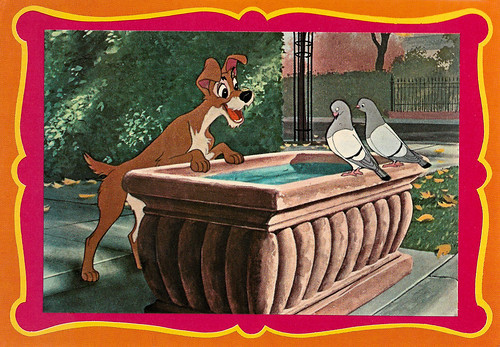
Belgian postcard by Edicorna / GB, no. 6/3307. Image: Walt Disney productions. Publicity still for Lady and the Tramp (Clyde Geronimi, Wilfred Jackson, Hamilton Luske, 1955).
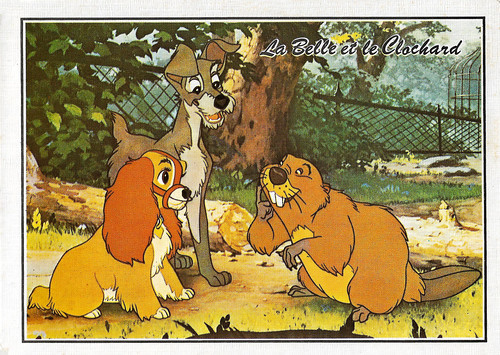
Italian postcard by Grafiche Biondetti S.R.L., Verona, no. 108. Image: Disney. Publicity still for Lady and the Tramp (Clyde Geronimi, Wilfred Jackson, Hamilton Luske, 1955).

French postcard by Editions Crès, Paris, no. 202, 1964. Caption: The Reunion. Image: Walt Disney Productions. Publicity still for Lady and the Tramp (Clyde Geronimi, Wilfred Jackson, Hamilton Luske, 1955).
Sources: Hal Erickson (AllMovie), Wikipedia and IMDb.

Italian postcard by Grafiche Biondetti S.R.L., Verona, no. 108. Image: Disney. Publicity still for Lady and the Tramp (Clyde Geronimi, Wilfred Jackson, Hamilton Luske, 1955).

Italian postcard by Grafiche Biondetti S.R.L., Verona, no. 108/3. Image: Disney. Publicity still for Lady and the Tramp (Clyde Geronimi, Wilfred Jackson, Hamilton Luske, 1955).

Italian postcard by Grafiche Biondetti S.R.L., Verona, no. 108/4. Image: Disney. Publicity still for Lady and the Tramp (Clyde Geronimi, Wilfred Jackson, Hamilton Luske, 1955).
When a baby moves in, a dog moves out
The story of Lady and the Tramp opens with a cute little American cocker spaniel puppy named Lady offered as a Christmas gift to 'Darling' by her husband Jim 'Dear'. The owners' names, besides the fact that their faces are rarely shown, accentuate the impression that we're watching the film from the dogs' perspectives.
Lady adores her a refined, upper-middle-class surroundings and receives the requited love of her owners. Six months later, that love hasn't diminished and she is a newly licensed pet. Lady has befriended two local neighbourhood dogs, a Scottish terrier named Jock, and a bloodhound named Trusty, suffering a busted sniffer.
But Lady learns that her owners are expecting a child, and suddenly Lady has been unwittingly pushed aside to make room for a new bundle of joy. The upset Lady meets up with a mongrel dog who calls himself the Tramp. He is obviously from the wrong side of the tracks, and Jock and Trusty take an immediate dislike to the stray and order him out of the yard. As Tramp leaves, he reminds Lady that "when a baby moves in, a dog moves out."
When Darling's snooty Aunt Sarah introduces Si and Am, her sneaky twin Siamese cats into the fold, Lady is certain that she's no longer welcome. The cats wreak all manner of havoc, for which Lady is blamed. After the poor dog is fitted with a muzzle, Lady escapes from the house. The Tramp saves Lady from a pack of other street dogs and helps her remove her muzzle. Then he takes her out on a night on the town, culminating in a romantic spaghetti dinner, courtesy of a pair of dog-loving Italian waiters. But her love with him will have bad consequences.
After many adventures, the film ends at Christmas. Tramp has been adopted into the family, and he and Lady have started their own family, with Lady having given birth to a litter of four puppies: three daughters who look identical to Lady and one son who looks identical to Tramp.

Belgian postcard by Editions Corna. Image: Walt Disney Productions. Publicity still for Lady and the Tramp (Clyde Geronimi, Wilfred Jackson, Hamilton Luske, 1955).

Belgian postcard by Editions Corna. Image: Walt Disney Productions. Publicity still for Lady and the Tramp (Clyde Geronimi, Wilfred Jackson, Hamilton Luske, 1955).

French postcard. Image: Walt Disney Productions. Publicity still for Lady and the Tramp (Clyde Geronimi, Wilfred Jackson, Hamilton Luske, 1955).

French postcard. Image: Walt Disney Productions. Publicity still for Lady and the Tramp (Clyde Geronimi, Wilfred Jackson, Hamilton Luske, 1955).
Bow-Wow-Wow! - And - Arf! Arf! Arf!
Lady and the Tramp (1955) would be Disney Studios' 15th animated feature film and the first to be produced in wide-screen Cinema-Scope. During the early 1950s Disney made some excellent animated features such as Alice in Wonderland (1951) and Peter Pan (1953), Lady and the Tramp followed those films and proved to be another good film from the studio.
Wikipedia writes that Lady and the Tramp was released to theatres on 22 June 1955 to box office success. "It initially received mixed to negative reviews by film critics, but critical reception for the film has been generally positive in modern times, and the film is now seen as one of the best animated films from Disney." Dave Kehr, writing for The Chicago Tribune gave the film four stars.
Lady and the Tramp is an unpretentious little gem, told from the viewpoint of the animals and against interesting backgrounds with superb animation. The film has a soft look and uses bright colours that give the upper class housing areas a rich gleam. The Peggy Lee music is delightful, especially the 'He's A Tramp' and 'We Are Siamese' songs. Lee also voiced the Darling, Peg and Si & Am characters.
Another highlight is the 'Bella Notte' sequence, with the spaghetti, breadsticks and the drippy candle. Wikipedia notes that Walt Disney was prepared to cut it, thinking that it would not be romantic and that dogs eating spaghetti would look silly.
Animator Frank Thomas was against Walt's decision and animated the entire scene himself without any lay-outs. Walt was impressed by Thomas's work and how he romanticised the scene and kept it in. And when Lady and her Tramp finally share a spaghetti strand, it leads to an accidental kiss, one of the most memorable kisses in Hollywood history. Bow-Wow-Wow! - And - Arf! Arf! Arf!

Belgian postcard by Edicorna / GB, no. 6/3307. Image: Walt Disney productions. Publicity still for Lady and the Tramp (Clyde Geronimi, Wilfred Jackson, Hamilton Luske, 1955).

Italian postcard by Grafiche Biondetti S.R.L., Verona, no. 108. Image: Disney. Publicity still for Lady and the Tramp (Clyde Geronimi, Wilfred Jackson, Hamilton Luske, 1955).

French postcard by Editions Crès, Paris, no. 202, 1964. Caption: The Reunion. Image: Walt Disney Productions. Publicity still for Lady and the Tramp (Clyde Geronimi, Wilfred Jackson, Hamilton Luske, 1955).
Sources: Hal Erickson (AllMovie), Wikipedia and IMDb.
Published on December 23, 2019 22:00
December 22, 2019
Leopoldo Fregoli
Legendary Italian protean (quick-change) artist Leopoldo Fregoli (1867-1936) was one of the first vaudeville actors who used film in his acts. Fregoli was famous for his rapid transformation acts, in which he did impersonations of famous artistic and political characters.
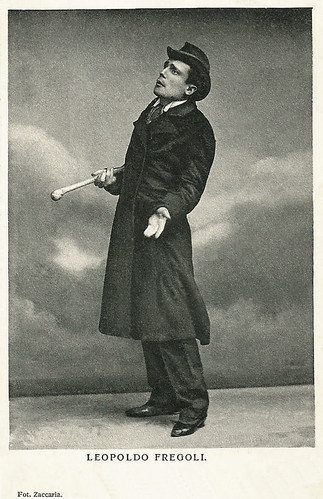
Italian postcard. Photo: Zaccaria.
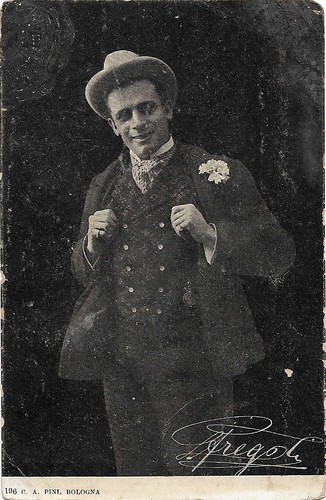
Italian postcard, no. 196. Photo C. A. Pini, Bologna.
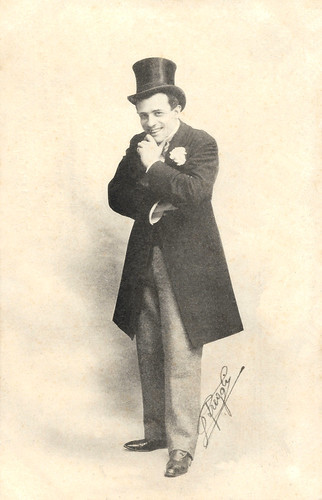
Italian postcard by Garzini e Pezzini, Milano, 1903.
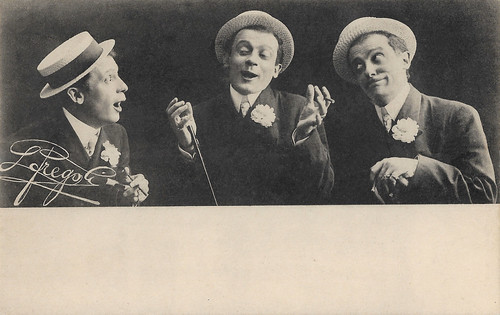
Italian postcard by Garzini e Pezzini, Milano, 1908.

Italian postcard, no. 86. Photo: Sciutto. Sent by mail in 1912.
Fregoli Syndrome
Leopoldo Luigi Fregoli was born in Rome, Italy in 1867. He was famous in the vaudeville for his rapid transformation acts, in which he did impersonations of famous artistic and political characters.
Originally an amateur entertainer, he took his first steps to professionalism while serving in the Italian army in Abyssinia under General Baldissera in 1890.
He soon conquered the Italian and the European stage. From March to May 1897, he was a huge success at the London Alhambra Theatre, in spite of his lack in speaking English.
While he was performing in London, unkind rumours spread that there was more than one Fregoli. He quickly quashed these rumours by inviting journalists and doubters backstage to see him at work: Fregoli had no secrets.
He knew several imitators in his time, including The Great Trickoli and Fregolina, and offered them advice about how to improve their performances. He did several tours in South America and in Italy and performed a full year at the Paris theatre Olympia, often returning there till 1910.
In 1922, Fregoli suddenly stopped his quickchange act while in Brazil, and returned to Italy. Fregoli died in 1936. His tombstone carries the words: 'His last transformation'.
After him the so-called Fregoli syndrome is named. Wikipedia describes it: "The Fregoli delusion or Fregoli syndrome is a rare disorder in which a person holds a delusional belief that different people are in fact a single person who changes appearance or is in disguise."
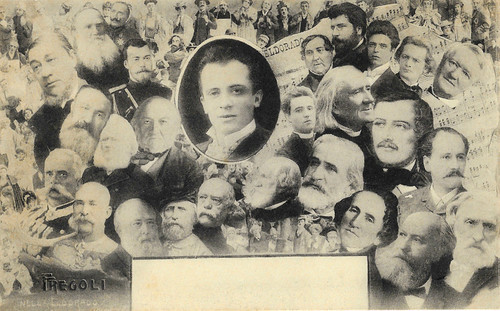
Italian postcard by Garzini e Pezzini, Milano, 1903. Caption: Fregoli nell' Eldorado (Fregoli at the Eldorado).
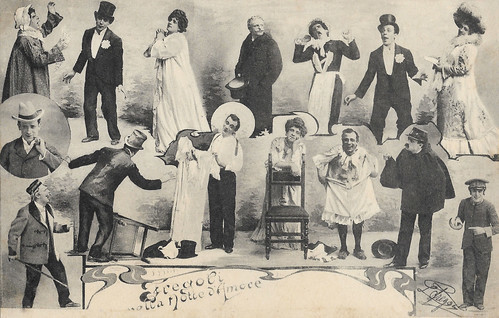
Italian postcard by Garzini e Pezzini, Milano, 1903. Caption: Fregoli nella Notte d'Amore (Fregoli in the Night of Love).
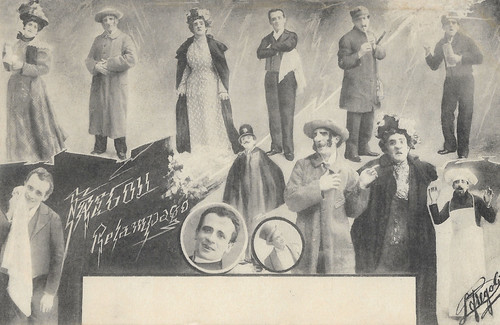
Italian postcard by Garzini e Pezzini, Milano, 1903. Caption: Fregoli Relampago (Spanish for Lightning).
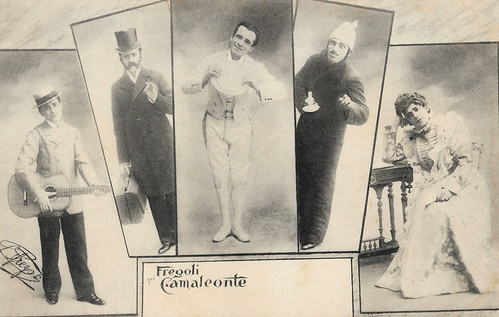
Italian postcard by Garzini e Pezzini, Milano, 1903. Caption: Fregoli Camaleonte (Fregoli Chameleon).
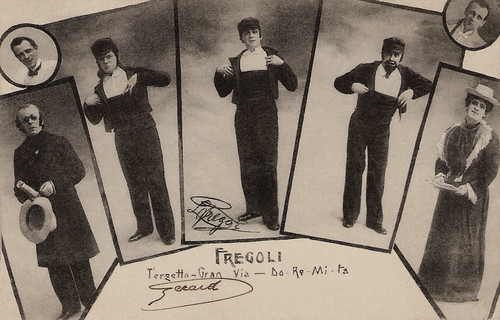
Italian postcard by Garzini & Pezzini, Milano, 1903. This postcard was sent in 1905 within Belgium from Dolhain (Limburg) to Anvers (Antwerp). Double click to see the postcard completely.
Fregoligraph
Leopoldo Fregoli was one of the first vaudeville artists to use film. After a visit to Lyon, Fregoli bought a Cinematographe from the Lumière brothers in 1898. He started to show shorts, named Fregoligraph, as part of his stage act.
As Luke McKernan writes at Who's Who in Victorian Cinema: "The films were no more than records of his various sketches, though he soon learned the possibilities of film trickery and began to employ surprise cuts and reverses."
Among his films were Danza serpentina/Serpentine Dance (Leopoldo Fregoli, 1897), Fregoli trasformista/Fregoli change-artist (Leopoldo Fregoli, 1898), and Dietro le quinte/Backstage (Leopoldo Fregoli, 1898).
In Maestri di musica/Fregoli, the Protean Artiste (Leopoldo Fregoli, 1898), Fregoli impersonated composers like Verdi, Wagner, and Rossini. In Commendator Ermete Novelli: Impressioni dalla critica/Commander Ermete Novelli: Impressions from the critics (Leopoldo Fregoli, 1899), he imitated the Italian actor and later film star Ermete Novelli .
His act was also filmed by the production company of British film pioneer Robert W. Paul, whose Fregoli, the Protean Artiste, in his Impersonation of Famous Composers (1898), was recorded at the Alhambra.
In Georges Méliès' l'Homme-Protée (1899), Fregoli played twenty different characters. Luke Mc Kernan: "His filming was, however, only a brief interlude in an international stage career that lasted many years. Fregoli was a dazzling entertainer whose exuberance and agility are readily apparent from the surviving films."
The Centro Sperimentale di Cinematografia in Rome has several of Fregoli's short films in its collection, which therefore belong to the oldest surviving Italian film material. A late echo of Fregoli's transformations can be traced in Giulietta Masina 's character's quickchange act in Luci del varietà/Variety Lights (Alberto Lattuada, Federico Fellini, 1950).
Fregoli's memoirs were published by Rizzoli publishers in 1936, the year of his death, as Fregoli raccontato da Fregoli. Le memorie del mago del trasformismo. At age 69, Leopoldo Fragoli died in 1936 in Viareggio, Italy.
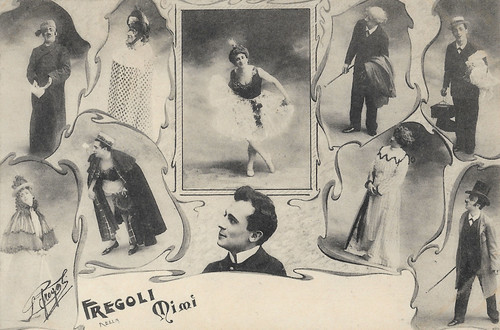
Italian postcard by Garzini e Pezzini, Milano, 1903. Caption: Fregoli nella Mimi.
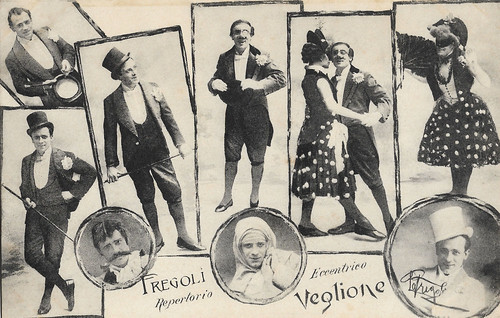
Italian postcard by Garzini e Pezzini, Milano, 1903. Caption: Fregoli repertorio Eccentrico Veglione.
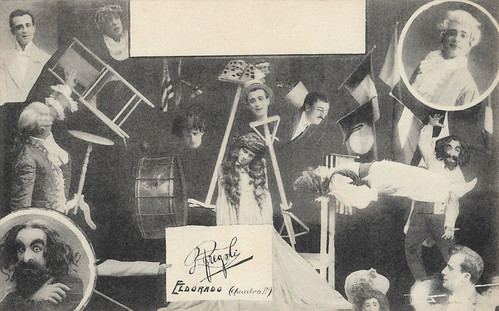
Italian postcard by Garzini e Pezzini, Milano, 1903. Caption: Fregoli in Eldorado.
Curiosanda in Cineteca (Italian). Source: Turifraska (YouTube).
Sources: Luke McKernan (Who's Who in Victorian Cinema), Wikipedia and .

Italian postcard. Photo: Zaccaria.

Italian postcard, no. 196. Photo C. A. Pini, Bologna.

Italian postcard by Garzini e Pezzini, Milano, 1903.

Italian postcard by Garzini e Pezzini, Milano, 1908.

Italian postcard, no. 86. Photo: Sciutto. Sent by mail in 1912.
Fregoli Syndrome
Leopoldo Luigi Fregoli was born in Rome, Italy in 1867. He was famous in the vaudeville for his rapid transformation acts, in which he did impersonations of famous artistic and political characters.
Originally an amateur entertainer, he took his first steps to professionalism while serving in the Italian army in Abyssinia under General Baldissera in 1890.
He soon conquered the Italian and the European stage. From March to May 1897, he was a huge success at the London Alhambra Theatre, in spite of his lack in speaking English.
While he was performing in London, unkind rumours spread that there was more than one Fregoli. He quickly quashed these rumours by inviting journalists and doubters backstage to see him at work: Fregoli had no secrets.
He knew several imitators in his time, including The Great Trickoli and Fregolina, and offered them advice about how to improve their performances. He did several tours in South America and in Italy and performed a full year at the Paris theatre Olympia, often returning there till 1910.
In 1922, Fregoli suddenly stopped his quickchange act while in Brazil, and returned to Italy. Fregoli died in 1936. His tombstone carries the words: 'His last transformation'.
After him the so-called Fregoli syndrome is named. Wikipedia describes it: "The Fregoli delusion or Fregoli syndrome is a rare disorder in which a person holds a delusional belief that different people are in fact a single person who changes appearance or is in disguise."

Italian postcard by Garzini e Pezzini, Milano, 1903. Caption: Fregoli nell' Eldorado (Fregoli at the Eldorado).

Italian postcard by Garzini e Pezzini, Milano, 1903. Caption: Fregoli nella Notte d'Amore (Fregoli in the Night of Love).

Italian postcard by Garzini e Pezzini, Milano, 1903. Caption: Fregoli Relampago (Spanish for Lightning).

Italian postcard by Garzini e Pezzini, Milano, 1903. Caption: Fregoli Camaleonte (Fregoli Chameleon).

Italian postcard by Garzini & Pezzini, Milano, 1903. This postcard was sent in 1905 within Belgium from Dolhain (Limburg) to Anvers (Antwerp). Double click to see the postcard completely.
Fregoligraph
Leopoldo Fregoli was one of the first vaudeville artists to use film. After a visit to Lyon, Fregoli bought a Cinematographe from the Lumière brothers in 1898. He started to show shorts, named Fregoligraph, as part of his stage act.
As Luke McKernan writes at Who's Who in Victorian Cinema: "The films were no more than records of his various sketches, though he soon learned the possibilities of film trickery and began to employ surprise cuts and reverses."
Among his films were Danza serpentina/Serpentine Dance (Leopoldo Fregoli, 1897), Fregoli trasformista/Fregoli change-artist (Leopoldo Fregoli, 1898), and Dietro le quinte/Backstage (Leopoldo Fregoli, 1898).
In Maestri di musica/Fregoli, the Protean Artiste (Leopoldo Fregoli, 1898), Fregoli impersonated composers like Verdi, Wagner, and Rossini. In Commendator Ermete Novelli: Impressioni dalla critica/Commander Ermete Novelli: Impressions from the critics (Leopoldo Fregoli, 1899), he imitated the Italian actor and later film star Ermete Novelli .
His act was also filmed by the production company of British film pioneer Robert W. Paul, whose Fregoli, the Protean Artiste, in his Impersonation of Famous Composers (1898), was recorded at the Alhambra.
In Georges Méliès' l'Homme-Protée (1899), Fregoli played twenty different characters. Luke Mc Kernan: "His filming was, however, only a brief interlude in an international stage career that lasted many years. Fregoli was a dazzling entertainer whose exuberance and agility are readily apparent from the surviving films."
The Centro Sperimentale di Cinematografia in Rome has several of Fregoli's short films in its collection, which therefore belong to the oldest surviving Italian film material. A late echo of Fregoli's transformations can be traced in Giulietta Masina 's character's quickchange act in Luci del varietà/Variety Lights (Alberto Lattuada, Federico Fellini, 1950).
Fregoli's memoirs were published by Rizzoli publishers in 1936, the year of his death, as Fregoli raccontato da Fregoli. Le memorie del mago del trasformismo. At age 69, Leopoldo Fragoli died in 1936 in Viareggio, Italy.

Italian postcard by Garzini e Pezzini, Milano, 1903. Caption: Fregoli nella Mimi.

Italian postcard by Garzini e Pezzini, Milano, 1903. Caption: Fregoli repertorio Eccentrico Veglione.

Italian postcard by Garzini e Pezzini, Milano, 1903. Caption: Fregoli in Eldorado.
Curiosanda in Cineteca (Italian). Source: Turifraska (YouTube).
Sources: Luke McKernan (Who's Who in Victorian Cinema), Wikipedia and .
Published on December 22, 2019 22:00
December 21, 2019
Cinderella (1950)
In the coming holiday season, EFSP will present some new film specials on Disney classics. Cinderella (Clyde Geronimi, Wilfred Jackson, Hamilton Luske, 1950), produced by Walt Disney and originally released by RKO Radio Pictures, is the twelfth Disney animated feature film. It was the last classic of Disney's 'golden age' and also started a new series of lavishly produced full-length feature films.
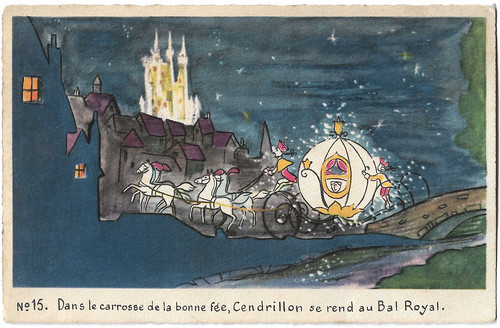
French postcard by Editions Superluxe, Paris, no. 15. Picture: Walt Disney Productions. Postcard for Cinderella (Clyde Geronimi, Wilfred Jackson, Hamilton Luske, 1950). Caption: In the carriage of the good fairy, Cinderella goes to the Royal Ball.
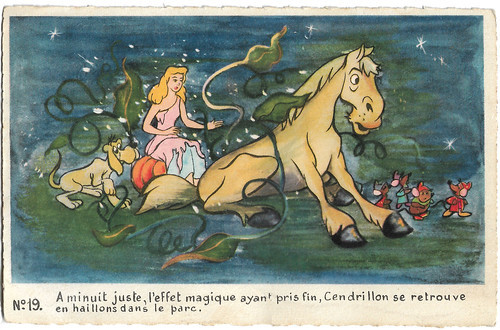
French postcard by Editions Superluxe, Paris, no. 19. Picture: Walt Disney Productions. Postcard for Cinderella (Clyde Geronimi, Wilfred Jackson, Hamilton Luske, 1950). Caption: At exactly midnight, the magic effect having ended, Cinderella is in rags in the park.
A classic fairy-tale from 1697
Cinderella (Clyde Geronimi, Wilfred Jackson, Hamilton Luske, 1950) is an adaptation of Charles Perrault's classic fairy-tale from 1697, and the film remains faithful to its origins.
Cinderella, the beautiful and kind-hearted daughter, sees her world turn upside down when her beloved mother dies, and her pained father remarries another woman, the wicked Lady Tremaine. She has two equally cruel daughters, the jealous Anastasia and Drizella.
But, once more, things will go from bad to worse, when Cinderella's father, too, dies, leaving her all alone in the Lady's clutches to serve as her maid-of-all-work.
When her cruel stepmother prevents the shabby and neglected Cinderella from attending the Royal Ball, she gets some unexpected help from the lovable mice Gus and Jaq, and from her Fairy Godmother who has quite a few tricks up her sleeve. Will she find peace and her Prince Charming?
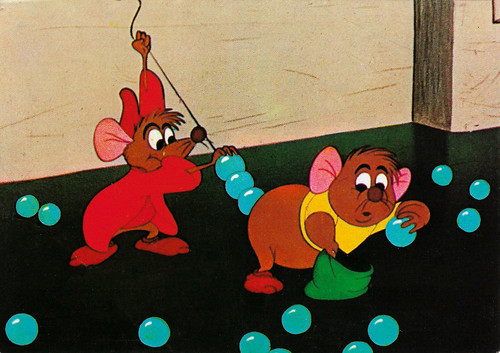
Italian postcard by Grafiche Biondetti, Verona, no. 104/6. Picture: Walt Disney Productions. Publicity still for Cinderella (Clyde Geronimi, Wilfred Jackson, Hamilton Luske, 1950).
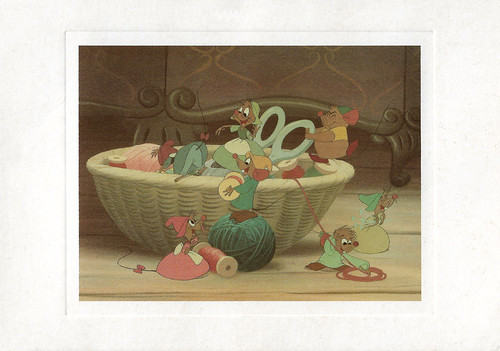
British postcard in the Disney Archive Collection by The Art Group Ltd., no. 8756. Picture: Disney. Publicity still for Cinderella (Clyde Geronimi, Wilfred Jackson, Hamilton Luske, 1950). Caption: "The mice make Cinderella a dress".
The last product of Disney's 'golden age'
Cinderella (Clyde Geronimi, Wilfred Jackson, Hamilton Luske, 1950) is seen as both an end and beginning for different eras of the Disney animation studio.
The 1930s and early 1940s produced the most critically acclaimed of the Disney animated films, often groundbreaking and experimental in nature, though several of them were commercial flops.
Walt Disney Productions had suffered from losing connections to the European film markets due to the outbreak of World War II, enduring some box office bombs like Pinocchio (1940), Fantasia (1940), and Bambi (1942). The studio was over $4 million in debt and was on the verge of bankruptcy.
The rest of the 1940s involved the release of cheaper package films, films consisting of several short films combined into one. Cinderella was arguably the last product of Disney's 'golden age' and was the the first of a new series of lavishly produced full-length feature films.
The Disney animated films of the 1950s were in general less artistic and experimental, more commercial in nature. Most of them were box office hits but their critical evaluation often places them below their predecessors. Made on the cusp between the two eras, Cinderella is representative of both eras.
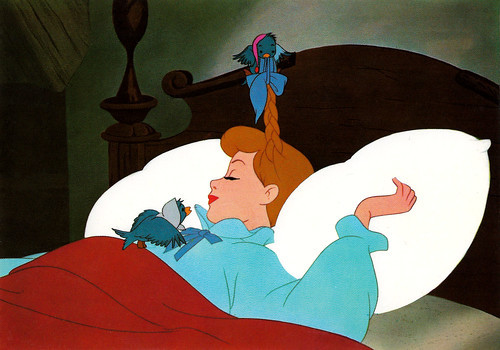
Italian postcard by Grafiche Biondetti, Verona, no. 104. Picture: Walt Disney Productions. Publicity still for Cinderella (Clyde Geronimi, Wilfred Jackson, Hamilton Luske, 1950).
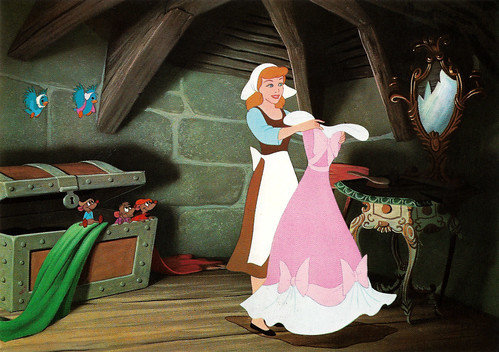
Italian postcard by Grafiche Biondetti, Verona, no. 104. Picture: Walt Disney Productions. Publicity still for Cinderella (Clyde Geronimi, Wilfred Jackson, Hamilton Luske, 1950).
Full of inventive comic touches
Cinderella (Clyde Geronimi, Wilfred Jackson, Hamilton Luske, 1950) received three Oscar nominations and became the greatest critical and commercial hit for the Disney studio since Snow White and the Seven Dwarfs (1937), and helped to reverse the studio's fortunes.
Among the artists responsible for the 'look' of Cinderella (1950), was Mary Blair, whose inspired use of colour was greatly admired by Disney. Her elegant French-period backgrounds add tremendously to the quality of the film.
But, most important of all' are the believable characters - from Cinderella, right down to Lucifer, the stepmother's deliciously evil black cat. They bring both life and vibrancy to the often told story, something very difficult to create in an animated film.
Disney gave the mice a big role in the main storyline, and this was the key to providing all the humour and suspense needed to spice up the predictable story. The leading mice, Gus and Jaq are delightful creations and the valiant band of mice are given amusing bits of business.
A highlight is the 'Cinderella Work Song' in which the mice make a dress for the mistreated Cinderella, full of inventive comic touches and accompanied by the intricate blend of song and animation. Mack David, Jerry Livingston, and Al Hoffman wrote the songs for Cinderella.
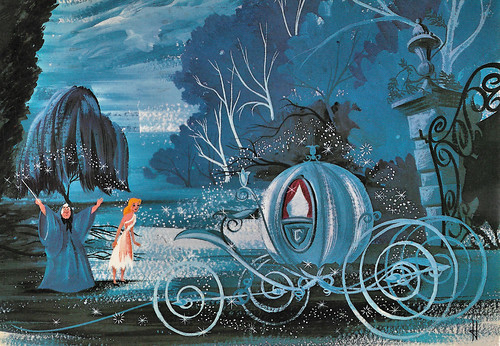
French postcard in the Le Monde Merveilleux de Walt Disney series by Diffusion Hachette, no. 104. Picture: Walt Disney Production. Publicity still for Cinderella (Clyde Geronimi, Wilfred Jackson, Hamilton Luske, 1950).
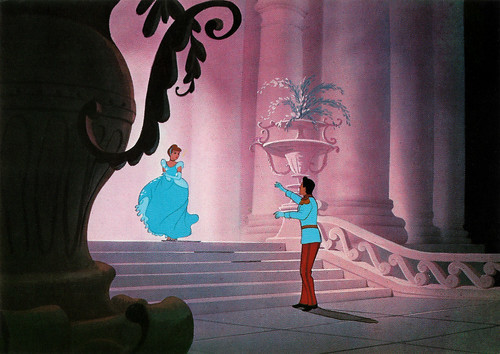
Italian postcard by Grafiche Biondetti, Verona, no. 104. Picture: Walt Disney Productions. Publicity still for Cinderella (Clyde Geronimi, Wilfred Jackson, Hamilton Luske, 1950).
Sources: Wikipedia and IMDb.

French postcard by Editions Superluxe, Paris, no. 15. Picture: Walt Disney Productions. Postcard for Cinderella (Clyde Geronimi, Wilfred Jackson, Hamilton Luske, 1950). Caption: In the carriage of the good fairy, Cinderella goes to the Royal Ball.

French postcard by Editions Superluxe, Paris, no. 19. Picture: Walt Disney Productions. Postcard for Cinderella (Clyde Geronimi, Wilfred Jackson, Hamilton Luske, 1950). Caption: At exactly midnight, the magic effect having ended, Cinderella is in rags in the park.
A classic fairy-tale from 1697
Cinderella (Clyde Geronimi, Wilfred Jackson, Hamilton Luske, 1950) is an adaptation of Charles Perrault's classic fairy-tale from 1697, and the film remains faithful to its origins.
Cinderella, the beautiful and kind-hearted daughter, sees her world turn upside down when her beloved mother dies, and her pained father remarries another woman, the wicked Lady Tremaine. She has two equally cruel daughters, the jealous Anastasia and Drizella.
But, once more, things will go from bad to worse, when Cinderella's father, too, dies, leaving her all alone in the Lady's clutches to serve as her maid-of-all-work.
When her cruel stepmother prevents the shabby and neglected Cinderella from attending the Royal Ball, she gets some unexpected help from the lovable mice Gus and Jaq, and from her Fairy Godmother who has quite a few tricks up her sleeve. Will she find peace and her Prince Charming?

Italian postcard by Grafiche Biondetti, Verona, no. 104/6. Picture: Walt Disney Productions. Publicity still for Cinderella (Clyde Geronimi, Wilfred Jackson, Hamilton Luske, 1950).

British postcard in the Disney Archive Collection by The Art Group Ltd., no. 8756. Picture: Disney. Publicity still for Cinderella (Clyde Geronimi, Wilfred Jackson, Hamilton Luske, 1950). Caption: "The mice make Cinderella a dress".
The last product of Disney's 'golden age'
Cinderella (Clyde Geronimi, Wilfred Jackson, Hamilton Luske, 1950) is seen as both an end and beginning for different eras of the Disney animation studio.
The 1930s and early 1940s produced the most critically acclaimed of the Disney animated films, often groundbreaking and experimental in nature, though several of them were commercial flops.
Walt Disney Productions had suffered from losing connections to the European film markets due to the outbreak of World War II, enduring some box office bombs like Pinocchio (1940), Fantasia (1940), and Bambi (1942). The studio was over $4 million in debt and was on the verge of bankruptcy.
The rest of the 1940s involved the release of cheaper package films, films consisting of several short films combined into one. Cinderella was arguably the last product of Disney's 'golden age' and was the the first of a new series of lavishly produced full-length feature films.
The Disney animated films of the 1950s were in general less artistic and experimental, more commercial in nature. Most of them were box office hits but their critical evaluation often places them below their predecessors. Made on the cusp between the two eras, Cinderella is representative of both eras.

Italian postcard by Grafiche Biondetti, Verona, no. 104. Picture: Walt Disney Productions. Publicity still for Cinderella (Clyde Geronimi, Wilfred Jackson, Hamilton Luske, 1950).

Italian postcard by Grafiche Biondetti, Verona, no. 104. Picture: Walt Disney Productions. Publicity still for Cinderella (Clyde Geronimi, Wilfred Jackson, Hamilton Luske, 1950).
Full of inventive comic touches
Cinderella (Clyde Geronimi, Wilfred Jackson, Hamilton Luske, 1950) received three Oscar nominations and became the greatest critical and commercial hit for the Disney studio since Snow White and the Seven Dwarfs (1937), and helped to reverse the studio's fortunes.
Among the artists responsible for the 'look' of Cinderella (1950), was Mary Blair, whose inspired use of colour was greatly admired by Disney. Her elegant French-period backgrounds add tremendously to the quality of the film.
But, most important of all' are the believable characters - from Cinderella, right down to Lucifer, the stepmother's deliciously evil black cat. They bring both life and vibrancy to the often told story, something very difficult to create in an animated film.
Disney gave the mice a big role in the main storyline, and this was the key to providing all the humour and suspense needed to spice up the predictable story. The leading mice, Gus and Jaq are delightful creations and the valiant band of mice are given amusing bits of business.
A highlight is the 'Cinderella Work Song' in which the mice make a dress for the mistreated Cinderella, full of inventive comic touches and accompanied by the intricate blend of song and animation. Mack David, Jerry Livingston, and Al Hoffman wrote the songs for Cinderella.

French postcard in the Le Monde Merveilleux de Walt Disney series by Diffusion Hachette, no. 104. Picture: Walt Disney Production. Publicity still for Cinderella (Clyde Geronimi, Wilfred Jackson, Hamilton Luske, 1950).

Italian postcard by Grafiche Biondetti, Verona, no. 104. Picture: Walt Disney Productions. Publicity still for Cinderella (Clyde Geronimi, Wilfred Jackson, Hamilton Luske, 1950).
Sources: Wikipedia and IMDb.
Published on December 21, 2019 22:00
December 20, 2019
Claudine Auger (1941-2019)
On 18 December 2019, French actress Claudine Auger (1941) passed away. She is best known as Bond girl Domino in the James Bond film Thunderball (1965). At 17, she was Miss France 1958 and she became the first runner-up in the Miss World contest. Later she worked mostly in France and Italy. Claudine Auger was 78.
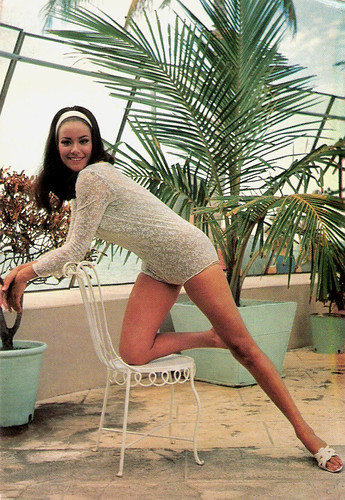
Spanish postcard by Postal Oscarcolor, Hospitalet (Barcelona), no. 608, 1966.
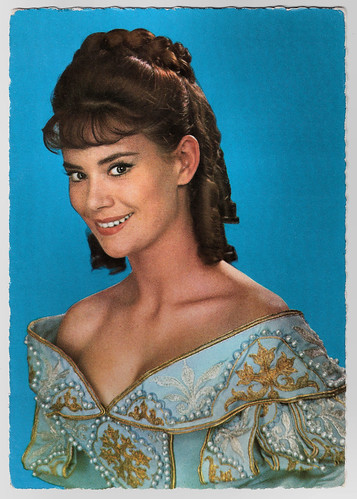
French postcard by E.D.U.G., no. 326. Photo: Sam Levin.

Belgian postcard by Edt. Decker, Brussels, no. A. 101. Offered by Korès.
James Bond
Claudine Auger was born Claudine Oger in Paris, France in 1941.
She attended St. Joan of Arc College. At the age of 16 the well-proportioned brunette earned the title of Miss France 1958 and was also the first runner-up in the 1958 Miss World contest. A year later, she married the 41-year-old writer-director Pierre Gaspard-Huit.
She attended the Paris Drama Conservatory, where she performed dramatic roles. Still at school, Jean Cocteau cast her as a tall ballerina in his final film Le testament d'Orphée, ou ne me demandez pas pourquoi!/The Testament of Orpheus (1960), about an ageing poet who knows he is dying.
She had her first leading lady role in the satirical Swashbuckler Le Masque de fer/The Iron Mask (Henri Decoin, 1962) opposite Jean Marais as the ageing musketeer D’Artagnan. She also starred opposite Pierre Étaix in his Tati-esque comedy Yoyo (Pierre Étaix, 1965).
On holiday in Nassau, she met writer-producer Kevin McClory. He recommended her for an audition for Thunderball (Terence Young, 1965), the fourth 007 mission featuring Sean Connery . She auditioned for the role of Domino, the mistress of international business executive and agent of the evil SPECTRE organisation Emilio Largo (Adolpho Celi). Domino was originally to be an Italian woman: Dominetta Petacchi.
Auger impressed the producers so much that they re-wrote the part into a French woman, Dominique Derval. Auger later claimed that she related to her character, as she and Domino were involved with older men. Although she took lessons to perfect her English, her voice was eventually dubbed by Nikki van der Zyl. Immediate by-products of Claudine's stardom were a semi-nude Playboy spread and a guest shot on an American TV special starring Danny Thomas and Bob Hope.
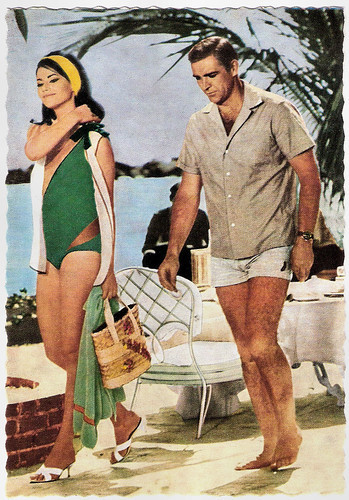
Vintage postcard. Photo: P.A. Reuter. Claudine Auger and Sean Connery in Thunderball (Terence Young, 1966).
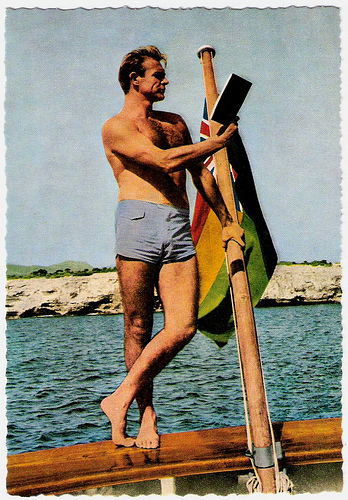
Sean Connery. Vintage German postcard. Photo: P.A. Reuter.
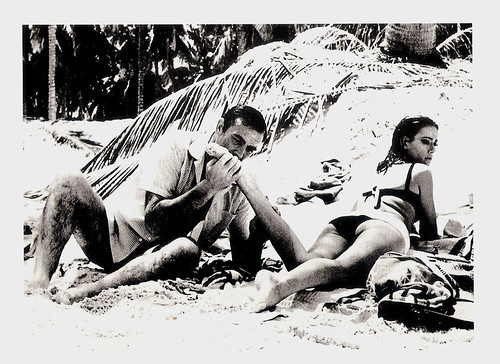
French postcard in the Collection Magie Noire by Editions Hazan, Paris, no. 6377, 1993. Photo: Claudine Auger and Sean Connery in Thunderball (Terence Young, 1966).
The Grandfather of the Modern Slasher Film
Thunderball launched Claudine Auger into a successful European film career, but it did little for her otherwise in the United States. In Europe, she reunited with her James Bond director Terence Young for the British-French Spy film Triple Cross (1966) with Christopher Plummer.
Other trendy sixties films in which she starred were the French-Spanish-Italian thriller L'Homme de Marrakesh/That Man George! (Jacques Deray, 1966), the Italian-French-German caper comedy Operazione San Gennaro/Operation San Gennaro (Dino Risi, 1967), the Italian-French sex comedy Le Dolci Signore/Anyone Can Play (Fausto Saraceni, Luigi Zampa, 1967) opposite Ursula Andress , the French satire Jeu De Massacre/The Killing Game (Alain Jessua, 1967) and the Italian fantastic comedy L'Arcidiavolo/The devil in Love (Ettore Scola, 1968) starring Vittorio Gassman .
One of her best films was Ecologia del delitto/Bay Of Blood (Mario Bava, 1971). This Giallo - an Italian genre of bloody horror-thrillers – is often cited as the grandfather of the modern slasher film. The film is known under several Italian titles, including Antefatto and Reazione a catena, the re-issue title. In English the film is also known as Carnage, Twitch of the Death Nerve and Blood Bath
Robert Firsching at AllMovie : “the film's style influenced countless American slasher films of the 1970s and 1980s. Bava also includes a strangulation by telephone cord, a gory axe decapitation, a man speared to a wall, and five other murders. Antefatto was a trendsetting film, and paved the way for literally hundreds of graphically violent imitations.”
Auger is the scheming daughter of a murdered Countess (played by film legend Isa Miranda ). Her staged suicide forms the basis of the film's plot.
With two other Bond girls, Barbara Bach and Barbara Bouchet, she appeared in another Giallo, La Tarantola dal ventre nero/Black Belly of the Tarantula (Paolo Cavara, 1972) starring Giancarlo Giannini.
That year she also co-starred with Christopher Mitchum, the son of Robert Mitchum , in the Italian action film Un verano para matar/Summertime Killer (Antonio Isasi-Isasmendi, 1972).
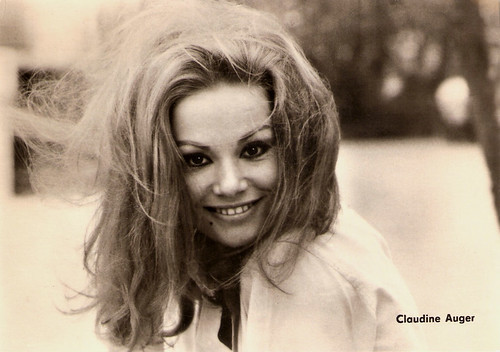
East-German postcard by VEB Progress Film-Vertrieb, Berlin, no. 3242, 1968.
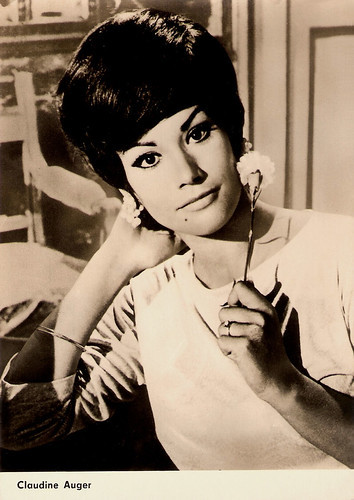
East-German postcard by VEB Progress Film-Vertrieb, Berlin, no. 3243, 1968. Photo: G.B. Poletto and Peter Basch.
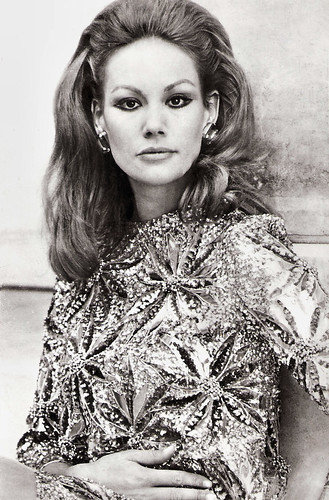
Romanian postcard by Casa Filmului Acin, no. 232.
Modern Noir
During the following decades, Claudine Auger kept busy in both the Italian and the French cinema. A classic is the French thriller Flic Story/Cop Story (Jacques Deray, 1975) starring Alain Delon and Jean-Louis Trintignant .
She again worked with Jacques Deray on his modern Noir Un Papillon sur l'Epaule/A butterfly on the shoulder (Jacques Deray, 1978) starring Lino Ventura .
James Travers reviews at Films de France : “In many ways, this is one of Jacques Deray’s most sophisticated and appealing films – the cobweb intrigue is masterfully woven, the detached photography evokes the sense of an unseen deadly threat throughout, and the minimalist script emphasises the feeling of isolation and helplessness of the film’s principal protagonist. It is a satisfying and compelling work, but also a profoundly disturbing one”.
In Italy she appeared in the comedy of errors Viaggio con Anita/Lovers and Liars (Mario Monicelli, 1979) starring Goldie Hawn and Giancarlo Giannini, and the domestic comedy Aragosta a Colazione/Lobster for Breakfast (Giorgio Capitani, 1979).
The French comedy L'Associé/The Associate (René Gainville, 1980), featuring Michel Serrault , lead in 1996 to a less successful American remake with Whoopi Goldberg.
In the UK Auger made Secret Places (Zelda Barron, Judith Lang, 1984) and the British-American production The Summer House (Waris Hussein, 1993) starring Jeanne Moreau .
Her last films were the erotic drama Salt on Our Skin/Desire (Andrew Birkin, 1993) with Greta Scacchi, and the Spanish comedy Los hombres siempre mienten/Men Always Lie (Antonio del Real, 1995). Later she worked incidentally for TV.
After her divorce from Pierre Gaspard-Huit, Claudine Auger was married to businessman Peter Brent until his death in 2008. After a long period of illness, Claudine Auger passed away in Paris on 18 December 2019.
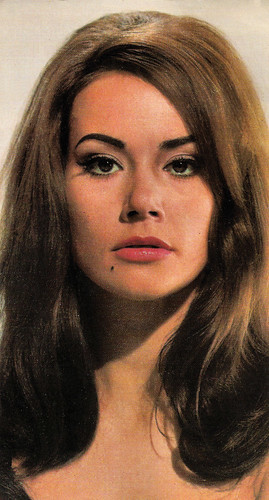
Belgian postcard in the Vedettes series of Victoria Chocolates by S. Best. Anvers (Antwerp) / Rotterdam, no. 2.

Belgian postcard by Edt. Decker, Brussels, no. A. 109.
Trailer for Thunderball (1965). Source: The Cult Box (YouTube).
Trailer for Ecologia del delitto/Bay Of Blood (1971). Source: Utterfright (YouTube).
Sources: Hal Erickson (AllMovie), Robert Firsching (AllMovie), James Travers (Films de France), Thomas Staedeli (Cyranos), Les Gens du Cinéma (French), Wikipedia, and .

Spanish postcard by Postal Oscarcolor, Hospitalet (Barcelona), no. 608, 1966.

French postcard by E.D.U.G., no. 326. Photo: Sam Levin.

Belgian postcard by Edt. Decker, Brussels, no. A. 101. Offered by Korès.
James Bond
Claudine Auger was born Claudine Oger in Paris, France in 1941.
She attended St. Joan of Arc College. At the age of 16 the well-proportioned brunette earned the title of Miss France 1958 and was also the first runner-up in the 1958 Miss World contest. A year later, she married the 41-year-old writer-director Pierre Gaspard-Huit.
She attended the Paris Drama Conservatory, where she performed dramatic roles. Still at school, Jean Cocteau cast her as a tall ballerina in his final film Le testament d'Orphée, ou ne me demandez pas pourquoi!/The Testament of Orpheus (1960), about an ageing poet who knows he is dying.
She had her first leading lady role in the satirical Swashbuckler Le Masque de fer/The Iron Mask (Henri Decoin, 1962) opposite Jean Marais as the ageing musketeer D’Artagnan. She also starred opposite Pierre Étaix in his Tati-esque comedy Yoyo (Pierre Étaix, 1965).
On holiday in Nassau, she met writer-producer Kevin McClory. He recommended her for an audition for Thunderball (Terence Young, 1965), the fourth 007 mission featuring Sean Connery . She auditioned for the role of Domino, the mistress of international business executive and agent of the evil SPECTRE organisation Emilio Largo (Adolpho Celi). Domino was originally to be an Italian woman: Dominetta Petacchi.
Auger impressed the producers so much that they re-wrote the part into a French woman, Dominique Derval. Auger later claimed that she related to her character, as she and Domino were involved with older men. Although she took lessons to perfect her English, her voice was eventually dubbed by Nikki van der Zyl. Immediate by-products of Claudine's stardom were a semi-nude Playboy spread and a guest shot on an American TV special starring Danny Thomas and Bob Hope.

Vintage postcard. Photo: P.A. Reuter. Claudine Auger and Sean Connery in Thunderball (Terence Young, 1966).

Sean Connery. Vintage German postcard. Photo: P.A. Reuter.

French postcard in the Collection Magie Noire by Editions Hazan, Paris, no. 6377, 1993. Photo: Claudine Auger and Sean Connery in Thunderball (Terence Young, 1966).
The Grandfather of the Modern Slasher Film
Thunderball launched Claudine Auger into a successful European film career, but it did little for her otherwise in the United States. In Europe, she reunited with her James Bond director Terence Young for the British-French Spy film Triple Cross (1966) with Christopher Plummer.
Other trendy sixties films in which she starred were the French-Spanish-Italian thriller L'Homme de Marrakesh/That Man George! (Jacques Deray, 1966), the Italian-French-German caper comedy Operazione San Gennaro/Operation San Gennaro (Dino Risi, 1967), the Italian-French sex comedy Le Dolci Signore/Anyone Can Play (Fausto Saraceni, Luigi Zampa, 1967) opposite Ursula Andress , the French satire Jeu De Massacre/The Killing Game (Alain Jessua, 1967) and the Italian fantastic comedy L'Arcidiavolo/The devil in Love (Ettore Scola, 1968) starring Vittorio Gassman .
One of her best films was Ecologia del delitto/Bay Of Blood (Mario Bava, 1971). This Giallo - an Italian genre of bloody horror-thrillers – is often cited as the grandfather of the modern slasher film. The film is known under several Italian titles, including Antefatto and Reazione a catena, the re-issue title. In English the film is also known as Carnage, Twitch of the Death Nerve and Blood Bath
Robert Firsching at AllMovie : “the film's style influenced countless American slasher films of the 1970s and 1980s. Bava also includes a strangulation by telephone cord, a gory axe decapitation, a man speared to a wall, and five other murders. Antefatto was a trendsetting film, and paved the way for literally hundreds of graphically violent imitations.”
Auger is the scheming daughter of a murdered Countess (played by film legend Isa Miranda ). Her staged suicide forms the basis of the film's plot.
With two other Bond girls, Barbara Bach and Barbara Bouchet, she appeared in another Giallo, La Tarantola dal ventre nero/Black Belly of the Tarantula (Paolo Cavara, 1972) starring Giancarlo Giannini.
That year she also co-starred with Christopher Mitchum, the son of Robert Mitchum , in the Italian action film Un verano para matar/Summertime Killer (Antonio Isasi-Isasmendi, 1972).

East-German postcard by VEB Progress Film-Vertrieb, Berlin, no. 3242, 1968.

East-German postcard by VEB Progress Film-Vertrieb, Berlin, no. 3243, 1968. Photo: G.B. Poletto and Peter Basch.

Romanian postcard by Casa Filmului Acin, no. 232.
Modern Noir
During the following decades, Claudine Auger kept busy in both the Italian and the French cinema. A classic is the French thriller Flic Story/Cop Story (Jacques Deray, 1975) starring Alain Delon and Jean-Louis Trintignant .
She again worked with Jacques Deray on his modern Noir Un Papillon sur l'Epaule/A butterfly on the shoulder (Jacques Deray, 1978) starring Lino Ventura .
James Travers reviews at Films de France : “In many ways, this is one of Jacques Deray’s most sophisticated and appealing films – the cobweb intrigue is masterfully woven, the detached photography evokes the sense of an unseen deadly threat throughout, and the minimalist script emphasises the feeling of isolation and helplessness of the film’s principal protagonist. It is a satisfying and compelling work, but also a profoundly disturbing one”.
In Italy she appeared in the comedy of errors Viaggio con Anita/Lovers and Liars (Mario Monicelli, 1979) starring Goldie Hawn and Giancarlo Giannini, and the domestic comedy Aragosta a Colazione/Lobster for Breakfast (Giorgio Capitani, 1979).
The French comedy L'Associé/The Associate (René Gainville, 1980), featuring Michel Serrault , lead in 1996 to a less successful American remake with Whoopi Goldberg.
In the UK Auger made Secret Places (Zelda Barron, Judith Lang, 1984) and the British-American production The Summer House (Waris Hussein, 1993) starring Jeanne Moreau .
Her last films were the erotic drama Salt on Our Skin/Desire (Andrew Birkin, 1993) with Greta Scacchi, and the Spanish comedy Los hombres siempre mienten/Men Always Lie (Antonio del Real, 1995). Later she worked incidentally for TV.
After her divorce from Pierre Gaspard-Huit, Claudine Auger was married to businessman Peter Brent until his death in 2008. After a long period of illness, Claudine Auger passed away in Paris on 18 December 2019.

Belgian postcard in the Vedettes series of Victoria Chocolates by S. Best. Anvers (Antwerp) / Rotterdam, no. 2.

Belgian postcard by Edt. Decker, Brussels, no. A. 109.
Trailer for Thunderball (1965). Source: The Cult Box (YouTube).
Trailer for Ecologia del delitto/Bay Of Blood (1971). Source: Utterfright (YouTube).
Sources: Hal Erickson (AllMovie), Robert Firsching (AllMovie), James Travers (Films de France), Thomas Staedeli (Cyranos), Les Gens du Cinéma (French), Wikipedia, and .
Published on December 20, 2019 22:00
December 19, 2019
Alice Terry
Alice Terry (1900–1987) was an American film actress and director, who appeared in almost 40 films between 1916 and 1933. Though a brunette, Terry's trademark look was her blonde hair, for which she wore wigs from 1920 onwards. Her most acclaimed role is the leading lady in The Four Horsemen of the Apocalypse (Rex Ingram, 1921) starring Rudolph Valentino. Ingram, who married her in 1921, would shoot her in many of his films and often paired her to Ramon Novarro. Terry proved also in films without her husband’s direction she was a legitimate star. In 1923 the couple moved to the French Riviera, where they set up a small studio in Nice and made several films on location in North Africa, Spain, and Italy.
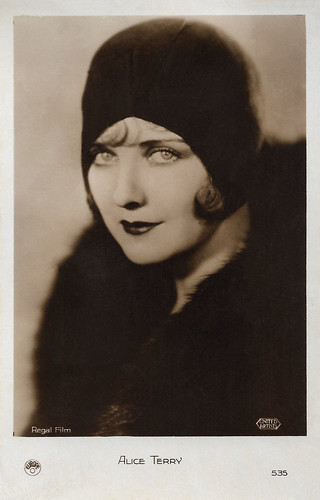
French postcard by Europe, no. 535. Photo: Regal Film / United Artists.

German postcard by Ross Verlag, no. 679/4. Lewis Stone as Rudolph Rassendyll and Alice Terry as Princess Flavia in The Prisoner of Zenda (Rex Ingram, 1922).
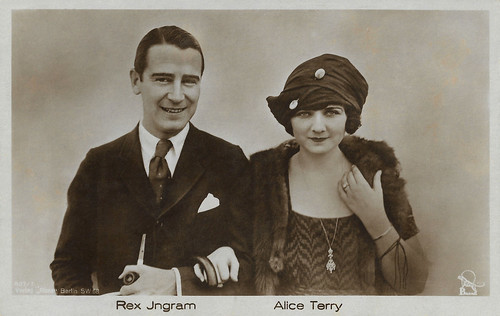
German postcard by Ross Verlag, Berlin, no. 807/1, 1925-1926. Photo: Bafag. With Rex Ingram .
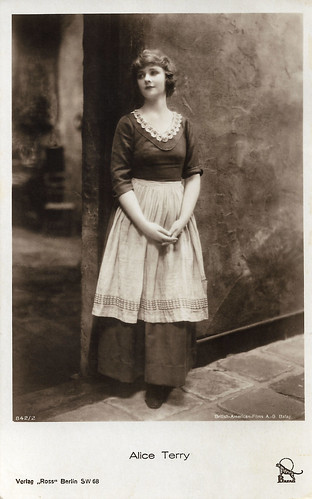
German postcard by Ross Verlag, no. 842/2, 1925-1926. Photo: British-American Film A.G. (Bafag).
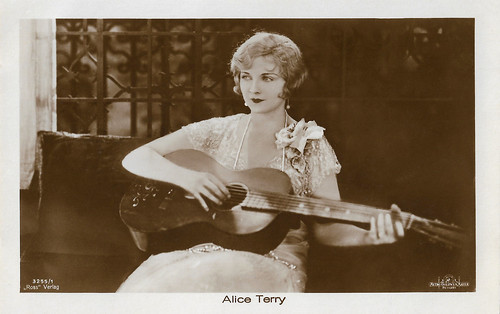
German postcard by Ross Verlag, no. 3255/1, 1928-1929. Photo: Metro-Goldwyn-Mayer (MGM). Alice Terry in Lovers? (John M. Stahl, 1927).
Rex and His Queen
Alice Terry was born as Alice Frances Taaffe in 1899 in Vincennes, Indiana, USA.
Alice started as an extra in films at age 15 to help her family financially. She made her film debut in Not My Sister (Charles Giblyn, 1916), opposite Bessie Barriscale and William Desmond Taylor. It was produced by legendary film pioneer Thomas Ince. She worked in "Inceville", Ince's studio, and would appear as an extra as several characters in his pacifist allegorical drama Civilization (Reginald Barker, Thomas H. Ince, 1916). The film was a big-budget spectacle that was compared to both The Birth of a Nation (D.W. Griffith, 1915) and the paintings of Jean-François Millet. Civilization was a popular success and was credited by the Democratic National Committee with helping to re-elect Woodrow Wilson as the U.S. President in 1916.
She was shy and was also interested in other motion picture jobs, considering work as a script girl or a cutter behind the camera as preferable to performing in front of it. For two years Alice worked in cutting rooms at Famous-Players-Lasky. This work would help her later on when she worked with Rex Ingram on his films. It was while she was working as an extra on The Devil's Passkey (Erich von Stroheim, 1920) that Alice was first noticed, by director Erich von Stroheim . Sadly, her insecurity caused her to rapidly leave the Universal lot. She never even stopped to pick up her paycheck.
In 1917, she had met director Rex Ingram . Ingram promoted her to small parts in his early Metro Pictures films in the late teens. He also directed her physical transformation, overseeing a program of weight loss and dental repair, and creating “Alice Terry” — both the name and the image — as his protege. He gave her her first significant role in Hearts Are Trumps (Rex Ingram, 1920). It was during preparation for this role that Alice discovered what would become her trademark.
IMDb : 'She was putting on her make-up and saw a blonde wig on the table next to her. She put it on but thought it looked silly. Just then the director Rex Ingram (who was already an admirer, both personally and professionally) walked in and saw her in it. He insisted she wear it in the film. Alice wasn't convinced until she saw the rushes the next day. "When I appeared on the screen, I looked so different, and from that time I never got rid of the wig."' Wikipedia adds that she put on her first blonde wig in Hearts Are Trumps (1920) 'to look different from Francelia Billington, the other actress in the film.'
Ingram and Terry would marry in 1921. It was also in 1921 that Alice would gain acclaim as Marguerite in The Four Horsemen of the Apocalypse (1921), with the blonde wig. Often regarded as one of the first true anti-war films, it had a huge cultural impact and became the top-grossing film of 1921, beating out Charlie Chaplin 's The Kid (1921). The film turned then-little-known actor Rudolph Valentino into a superstar and associated him with the image of the Latin Lover. The film also inspired a tango craze and such fashion fads as gaucho pants.
For her husband, she would continue to play the heroine is such masterpieces as The Prisoner of Zenda (Rex Ingram, 1922) in which she appeared as Princess Flavia opposite Lewis Stone and the upcoming Ramon Novarro as the bad guy, and Scaramouche (Rex Ingram, 1923), now featuring Ramon Novarro . Both films were smash hits. Heidi Kenaga at Women Film Pioneer's Project : '“Rex and His Queen” were one of the more celebrated director-actress teams of the 1920s, but there are indications that performing was only one dimension of Terry’s contribution to their work together.'
In 1924 and 1925 the marriage between Terry and Ingram was in jeopardy, according to Wikipedia , and in that time period she worked under other directors. Alice worked on five films, and particularly her roles in Any Woman (Henry King, 1925) and Sackcloth and Scarlet (Henry King, 1925), both by Paramount Pictures, proved that Alice was a legitimate star away from her husband. She also would make the Western melodrama The Great Divide (Reginald Barker, 1924) with Conway Tearle and Wallace Beery.
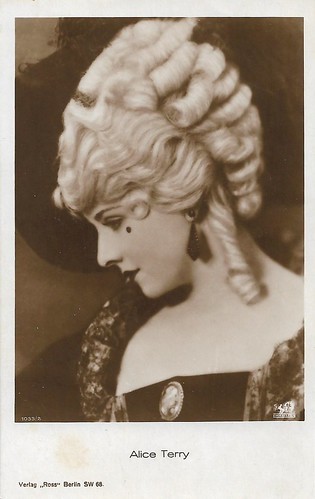
German postcard by Ross Verlag, no. 1033/2. Photo: Phoebus Film. Alice Terry in Scaramouche (Rex Ingram, 1923).
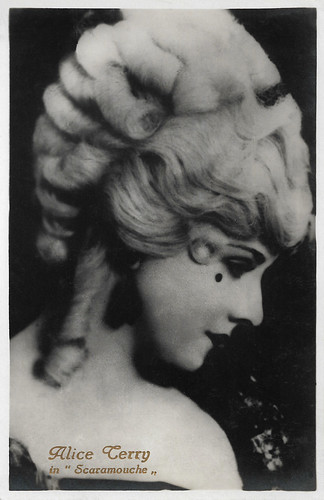
Italian postcard by G. Vettori, Bologna, no. 409. Photo: Metro-Goldwyn. Alice Terry in Scaramouche (Rex Ingram, 1923).
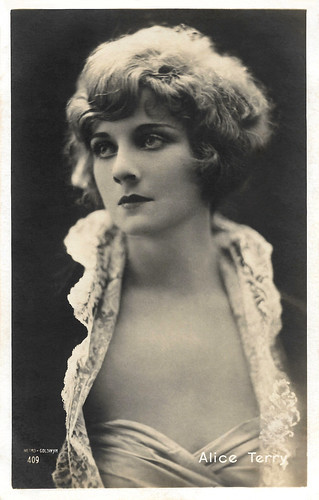
Italian postcard by G. Vettori, Bologna, no. 409. Photo: Metro-Goldwyn.
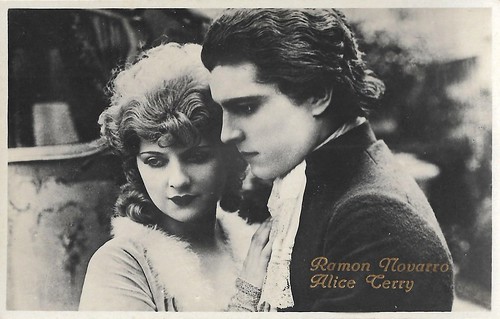
Italian postcard by G.B. Falci, Milano, no. 447. Ramon Novarro and Alice Terry in the Metro Pictures production Scaramouche (Rex Ingram, 1923).
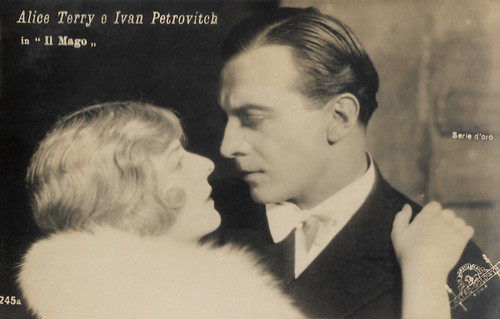
Italian postcard in the Serie d'Oro by Casa Editrice Ballerini & Fratini, Firenze, no. 245a. Photo: Metro-Goldwyn-Mayer. Alice Terry and Ivan Petrovich in The Magician (Rex Ingram, 1926).
The only Mrs. Rex Ingram
In 1924, Metro would merge into the new MGM and both Rex Ingram and Alice Terry would work there. She would be directed again by Ingram in The Arab (1924), which was filmed in North Africa and owed much to the influence of screen idol Valentino. When they got back together, Terry took on a more behind-the-scenes role. During the making of The Arab (Rex Ingram, 1924) in Tunisia, they met a street child named Kada-Abd-el-Kader, whom they adopted upon learning that he was an orphan. Allegedly, el-Kader misrepresented his age to make himself seem younger to his adoptive parents.
In 1925 Ingram co-directed Ben-Hur, filming parts of it in Italy. The two decided to move to the French Riviera, where they set up a small studio in Nice and started to make films on location in North Africa, Spain, and Italy. Alice would get her chance to play the wicked woman in Mare Nostrum (Rex Ingram, 1926). Filmed in Italy and Spain, this film was both a critical and financial success for the couple.
Ingram would make his third independent film in Italy when he directed Alice in The Garden of Allah (Rex Ingram, 1927). Later that year, Alice would be reunited with Ramon Novarro in Lovers? (John M. Stahl, 1927), but the film would not be as well received as their earlier films.
When sound came to the screen Alice and Rex retired. Her last film appearance was in the sound film Baroud (1933) starring Pierre Batcheff , which she also co-directed with husband. Alice helped so much that she was named co-director and she directed all the scenes Ingram himself appeared in. Wikipedia : 'Baroud (Rex Ingram, Alice Terry, 1933) highlighted Alice's ability as an all around filmmaker but she never took that further.'
Terry and Ingram retired in the 1930s and took up painting. Once Terry and Ingram moved back to the United States they started having problems with their adopted son, Kada-Abd-el-Kader. According to Wikipedia , He 'began associating with fast women and fast cars throughout the San Fernando Valley.' Terry and Ingram sent him back to Morocco 'to finish school.' Kada-Abd-el-Kader never went back to school, but he later became a tourist guide in Morocco and Algiers. El-Kader would always tell tourists that he was the adopted son of Rex Ingram and Alice Terry
In 1950, Rex Ingram passed away. Terry was open-minded and she invited four of Rex's mistresses to his funeral. Wikipedia quotes her saying: 'Who cares, I'm the only one that can call herself Mrs. Rex Ingram.' A year later, when Columbia released Valentino (Lewis Allen, 1951), featuring Eleanor Parker and Anthony Dexter, Alice Terry filed suit against Columbia and the producers because of the way the film "falsely portrayed a clandestine relationship between Valentino and Terry". Columbia settled out of court for an undisclosed sum.
In 1960, she was awarded a Star on the Hollywood Walk of Fame at 6628 Hollywood Boulevard in Hollywood, California. Terry was still active in the 1970s. She loved hosting Sunday afternoon parties and going out to dinner in extravagant, floor length mink coats. Alzheimer's put a stop to Terry's parties and fun. Following her death in 1987 in Burbank, California by pneumonia, Alice Terry was interred at Vahalla Memorial Park Cemetery in North Hollywood.
Alice Terry made 29 films, not counting four appearances as an extra. Of these 29, 17 are lost films. Six exist in archives around the world and six survive on video and on television broadcast release.
About her part in Rex Ingram 's films, Picture Play commented in a 1924 article, she was set apart by “her unrestrained enthusiasm for her husband, her unqualified praise for his work, with absolutely no mention of her own minor but definite achievements.” Heidi Kenaga gives her at Women Film Pioneer's Project full credit for the films she made with Ingram and cites film historian Anthony Slide: 'although Terry is only given on-screen credit for Baroud — a sound film made after Ingram’s heyday and outside the US studio system — it is possible she also co-directed some parts of Ingram’s motion pictures between 1921 and 1929.'
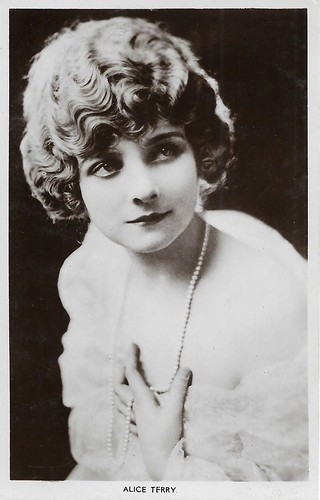
British postcard in the Picturegoer Series, London, no. 19.
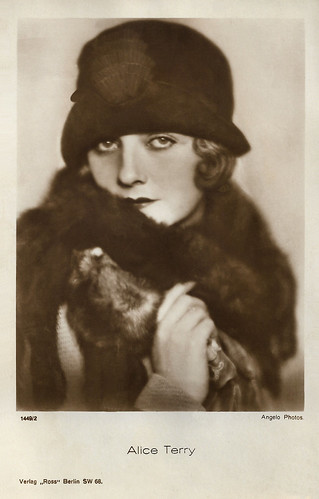
German postcard. by Ross Verlag, no. 1449/2, 1927-1928. Photo: Angelo Photos.
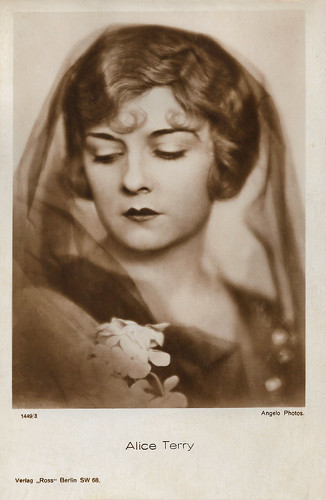
German postcard. by Ross Verlag, no. 1449/3, 1927-1928. Photo: Angelo Photos.
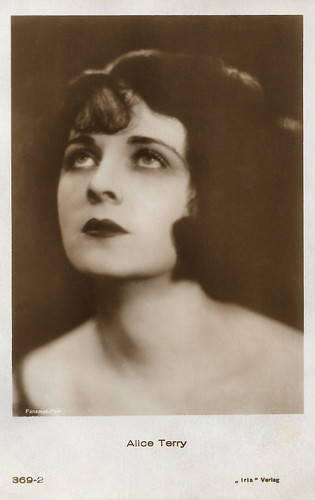
Austrian postcard by Iris Verlag, no. 369/2, 1927-1928. Photo: Fanamet-Film.
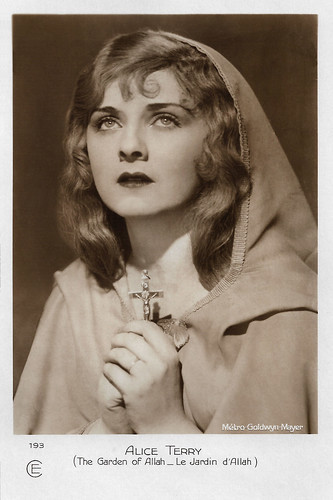
French postcard by Editions Cinémagazine, no. 193. Photo: Metro-Goldwyn-Mayer. Alice Terry in The Garden of Allah (Rex Ingram, 1927).
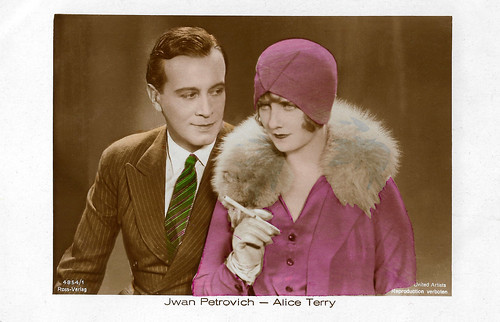
German postcard by Ross Verlag, no. 4854/1, 1929-1930. Photo: United Artists. Ivan Petrovich and Alice Terry in The Three Passions (Rex Ingram, 1928). Collection: Geoffrey Donaldson Institute.
Sources: Heidi Kenaga (Women Film Pioneer's Project), (IMDb), Wikipedia and .

French postcard by Europe, no. 535. Photo: Regal Film / United Artists.

German postcard by Ross Verlag, no. 679/4. Lewis Stone as Rudolph Rassendyll and Alice Terry as Princess Flavia in The Prisoner of Zenda (Rex Ingram, 1922).

German postcard by Ross Verlag, Berlin, no. 807/1, 1925-1926. Photo: Bafag. With Rex Ingram .

German postcard by Ross Verlag, no. 842/2, 1925-1926. Photo: British-American Film A.G. (Bafag).

German postcard by Ross Verlag, no. 3255/1, 1928-1929. Photo: Metro-Goldwyn-Mayer (MGM). Alice Terry in Lovers? (John M. Stahl, 1927).
Rex and His Queen
Alice Terry was born as Alice Frances Taaffe in 1899 in Vincennes, Indiana, USA.
Alice started as an extra in films at age 15 to help her family financially. She made her film debut in Not My Sister (Charles Giblyn, 1916), opposite Bessie Barriscale and William Desmond Taylor. It was produced by legendary film pioneer Thomas Ince. She worked in "Inceville", Ince's studio, and would appear as an extra as several characters in his pacifist allegorical drama Civilization (Reginald Barker, Thomas H. Ince, 1916). The film was a big-budget spectacle that was compared to both The Birth of a Nation (D.W. Griffith, 1915) and the paintings of Jean-François Millet. Civilization was a popular success and was credited by the Democratic National Committee with helping to re-elect Woodrow Wilson as the U.S. President in 1916.
She was shy and was also interested in other motion picture jobs, considering work as a script girl or a cutter behind the camera as preferable to performing in front of it. For two years Alice worked in cutting rooms at Famous-Players-Lasky. This work would help her later on when she worked with Rex Ingram on his films. It was while she was working as an extra on The Devil's Passkey (Erich von Stroheim, 1920) that Alice was first noticed, by director Erich von Stroheim . Sadly, her insecurity caused her to rapidly leave the Universal lot. She never even stopped to pick up her paycheck.
In 1917, she had met director Rex Ingram . Ingram promoted her to small parts in his early Metro Pictures films in the late teens. He also directed her physical transformation, overseeing a program of weight loss and dental repair, and creating “Alice Terry” — both the name and the image — as his protege. He gave her her first significant role in Hearts Are Trumps (Rex Ingram, 1920). It was during preparation for this role that Alice discovered what would become her trademark.
IMDb : 'She was putting on her make-up and saw a blonde wig on the table next to her. She put it on but thought it looked silly. Just then the director Rex Ingram (who was already an admirer, both personally and professionally) walked in and saw her in it. He insisted she wear it in the film. Alice wasn't convinced until she saw the rushes the next day. "When I appeared on the screen, I looked so different, and from that time I never got rid of the wig."' Wikipedia adds that she put on her first blonde wig in Hearts Are Trumps (1920) 'to look different from Francelia Billington, the other actress in the film.'
Ingram and Terry would marry in 1921. It was also in 1921 that Alice would gain acclaim as Marguerite in The Four Horsemen of the Apocalypse (1921), with the blonde wig. Often regarded as one of the first true anti-war films, it had a huge cultural impact and became the top-grossing film of 1921, beating out Charlie Chaplin 's The Kid (1921). The film turned then-little-known actor Rudolph Valentino into a superstar and associated him with the image of the Latin Lover. The film also inspired a tango craze and such fashion fads as gaucho pants.
For her husband, she would continue to play the heroine is such masterpieces as The Prisoner of Zenda (Rex Ingram, 1922) in which she appeared as Princess Flavia opposite Lewis Stone and the upcoming Ramon Novarro as the bad guy, and Scaramouche (Rex Ingram, 1923), now featuring Ramon Novarro . Both films were smash hits. Heidi Kenaga at Women Film Pioneer's Project : '“Rex and His Queen” were one of the more celebrated director-actress teams of the 1920s, but there are indications that performing was only one dimension of Terry’s contribution to their work together.'
In 1924 and 1925 the marriage between Terry and Ingram was in jeopardy, according to Wikipedia , and in that time period she worked under other directors. Alice worked on five films, and particularly her roles in Any Woman (Henry King, 1925) and Sackcloth and Scarlet (Henry King, 1925), both by Paramount Pictures, proved that Alice was a legitimate star away from her husband. She also would make the Western melodrama The Great Divide (Reginald Barker, 1924) with Conway Tearle and Wallace Beery.

German postcard by Ross Verlag, no. 1033/2. Photo: Phoebus Film. Alice Terry in Scaramouche (Rex Ingram, 1923).

Italian postcard by G. Vettori, Bologna, no. 409. Photo: Metro-Goldwyn. Alice Terry in Scaramouche (Rex Ingram, 1923).

Italian postcard by G. Vettori, Bologna, no. 409. Photo: Metro-Goldwyn.

Italian postcard by G.B. Falci, Milano, no. 447. Ramon Novarro and Alice Terry in the Metro Pictures production Scaramouche (Rex Ingram, 1923).

Italian postcard in the Serie d'Oro by Casa Editrice Ballerini & Fratini, Firenze, no. 245a. Photo: Metro-Goldwyn-Mayer. Alice Terry and Ivan Petrovich in The Magician (Rex Ingram, 1926).
The only Mrs. Rex Ingram
In 1924, Metro would merge into the new MGM and both Rex Ingram and Alice Terry would work there. She would be directed again by Ingram in The Arab (1924), which was filmed in North Africa and owed much to the influence of screen idol Valentino. When they got back together, Terry took on a more behind-the-scenes role. During the making of The Arab (Rex Ingram, 1924) in Tunisia, they met a street child named Kada-Abd-el-Kader, whom they adopted upon learning that he was an orphan. Allegedly, el-Kader misrepresented his age to make himself seem younger to his adoptive parents.
In 1925 Ingram co-directed Ben-Hur, filming parts of it in Italy. The two decided to move to the French Riviera, where they set up a small studio in Nice and started to make films on location in North Africa, Spain, and Italy. Alice would get her chance to play the wicked woman in Mare Nostrum (Rex Ingram, 1926). Filmed in Italy and Spain, this film was both a critical and financial success for the couple.
Ingram would make his third independent film in Italy when he directed Alice in The Garden of Allah (Rex Ingram, 1927). Later that year, Alice would be reunited with Ramon Novarro in Lovers? (John M. Stahl, 1927), but the film would not be as well received as their earlier films.
When sound came to the screen Alice and Rex retired. Her last film appearance was in the sound film Baroud (1933) starring Pierre Batcheff , which she also co-directed with husband. Alice helped so much that she was named co-director and she directed all the scenes Ingram himself appeared in. Wikipedia : 'Baroud (Rex Ingram, Alice Terry, 1933) highlighted Alice's ability as an all around filmmaker but she never took that further.'
Terry and Ingram retired in the 1930s and took up painting. Once Terry and Ingram moved back to the United States they started having problems with their adopted son, Kada-Abd-el-Kader. According to Wikipedia , He 'began associating with fast women and fast cars throughout the San Fernando Valley.' Terry and Ingram sent him back to Morocco 'to finish school.' Kada-Abd-el-Kader never went back to school, but he later became a tourist guide in Morocco and Algiers. El-Kader would always tell tourists that he was the adopted son of Rex Ingram and Alice Terry
In 1950, Rex Ingram passed away. Terry was open-minded and she invited four of Rex's mistresses to his funeral. Wikipedia quotes her saying: 'Who cares, I'm the only one that can call herself Mrs. Rex Ingram.' A year later, when Columbia released Valentino (Lewis Allen, 1951), featuring Eleanor Parker and Anthony Dexter, Alice Terry filed suit against Columbia and the producers because of the way the film "falsely portrayed a clandestine relationship between Valentino and Terry". Columbia settled out of court for an undisclosed sum.
In 1960, she was awarded a Star on the Hollywood Walk of Fame at 6628 Hollywood Boulevard in Hollywood, California. Terry was still active in the 1970s. She loved hosting Sunday afternoon parties and going out to dinner in extravagant, floor length mink coats. Alzheimer's put a stop to Terry's parties and fun. Following her death in 1987 in Burbank, California by pneumonia, Alice Terry was interred at Vahalla Memorial Park Cemetery in North Hollywood.
Alice Terry made 29 films, not counting four appearances as an extra. Of these 29, 17 are lost films. Six exist in archives around the world and six survive on video and on television broadcast release.
About her part in Rex Ingram 's films, Picture Play commented in a 1924 article, she was set apart by “her unrestrained enthusiasm for her husband, her unqualified praise for his work, with absolutely no mention of her own minor but definite achievements.” Heidi Kenaga gives her at Women Film Pioneer's Project full credit for the films she made with Ingram and cites film historian Anthony Slide: 'although Terry is only given on-screen credit for Baroud — a sound film made after Ingram’s heyday and outside the US studio system — it is possible she also co-directed some parts of Ingram’s motion pictures between 1921 and 1929.'

British postcard in the Picturegoer Series, London, no. 19.

German postcard. by Ross Verlag, no. 1449/2, 1927-1928. Photo: Angelo Photos.

German postcard. by Ross Verlag, no. 1449/3, 1927-1928. Photo: Angelo Photos.

Austrian postcard by Iris Verlag, no. 369/2, 1927-1928. Photo: Fanamet-Film.

French postcard by Editions Cinémagazine, no. 193. Photo: Metro-Goldwyn-Mayer. Alice Terry in The Garden of Allah (Rex Ingram, 1927).

German postcard by Ross Verlag, no. 4854/1, 1929-1930. Photo: United Artists. Ivan Petrovich and Alice Terry in The Three Passions (Rex Ingram, 1928). Collection: Geoffrey Donaldson Institute.
Sources: Heidi Kenaga (Women Film Pioneer's Project), (IMDb), Wikipedia and .
Published on December 19, 2019 22:00
Paul van Yperen's Blog
- Paul van Yperen's profile
- 13 followers
Paul van Yperen isn't a Goodreads Author
(yet),
but they
do have a blog,
so here are some recent posts imported from
their feed.



